NEW YORK:
- History:
- The Dutch Period (1654-64):
- Settlers in New Amsterdam.
- Attitude of Stuyvesant.
- Influence on Colonial Foreign Trade.
- English Period (1664-1776):
- The Synagogue.
- Not Allowed to Vote for Assembly.
- Commercial Activity.
- The Couty Appeal.
- Shearith Israel.
- Beginnings of Emancipation.
- Revolutionary Period:
- Gershom Mendez Seixas.
- Beginnings of Charity Organization.
- From 1812 to 1881:
- Hendricks and Noah.
- Enter the Professions.
- New Influx; New Synagogues.
- Beginnings of Temples Beth-El and Emanu-El.
- Clergy and Press.
- Hebrew Benevolent Societies.
- Opening of Official Careers.
- Social Condition About 1848.
- The Orders and the Schools.
- New Synagogues, 1850-80.
- Board of Delegates.
- During the Civil War.
- Hebrew Orphan Asylum.
- Period 1870-1881.
- Ethical-Culture Movement.
- From 1881 to 1904:
- The Russian Immigration.
- The Montefiore Centenary.
- 1891-1904.
- Jewish Theological Seminary.
- Ministerial Changes.
- Academic Positions.
- Recent Events.
- In Public Life.
- Population.
- —Present Condition:
- Distribution.
- United Hebrew Charities.
- Asylums for Children.
- Aged Poor and the Hospitals.
- Montefiore Home.
- Education.
- Religious Instruction.
- Educational Alliance.
- The Hirsch Funds.
- Jewish Agricultural Aid Society.
- Synagogues.
- Beth Elohim Congregation.
- —Brooklyn:
- Beth Israel.
- Effect of Russo-Jewish Immigration.
- Cemeteries.
Chief commercial city of the state of New York and the largest city of the United States; contains a larger Jewish population than any other city in the world.
History:When Jews settled in New York, about 1654, during the Dutch period, the Jewish population of Holland was very small, and the Jewish settlers were largely Sephardic exiles from Brazil and the West Indies, with an appreciable sprinkling of Ashkenazim from Holland and, subsequently, from England. England, to which Jews were readmitted soon after, had only a small Jewish population, and accordingly there were few Jewish immigrant settlers from that country during the period of English dominion, from 1664 to the close of the Revolution. It was only from the beginning of the nineteenth century, when the German tide of immigration to America became considerable, carrying in its wake a Polish Jewish immigration, that the Jewish population of New York was heavily augmented. A new influx began about 1881, when Russian persecution drove hundreds of thousands of Jews to America's shores, Rumanian persecution during the last five years further augmenting the number. The history of the growth of the New York Jewry falls therefore into three periods; the first runs to 1812, when it numbered approximately five hundred souls; the next, the period of German immigration, runs to about 1881; the third period, that of Russian immigration, extends from that date to the present time (1904), when the Jewish population of the city is estimated at 672,776.
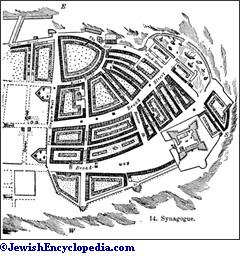
It was fortunate for American Jewry that the territory of New York, then known as New Netherlands, was a Dutch possession in 1654. This was so not merely because some of the most enterprising of the Jews who fled from Brazil in that year, upon the Dutch capitulation, were enabled to look with considerable confidence to Dutch hospitality there, but because the more liberal and modern Dutch laws continued in theory and in practise to confer greater rights and privileges upon Jewish residents in New York under the English conquerors than England herself granted for many decades after. But Jewish relations to the Dutch colony of New Netherlands considerably antedated the first settlement of Jews there. When the Dutch West Indies Company was formed in 1620, Jews became influential stockholders and began immediately to exert an important influence upon the shaping of the company's fortunes.
Settlers in New Amsterdam.When the Dutch were finally expelled from Brazil, in 1654, several thousand Jews resident there felt compelled to take to flight, and a party of twenty-three of these fugitives arrived at New Amsterdam on the ship "Saint Catarina" in Sept., 1654, and formed the first considerable avowedly Jewish settlement within the present limits of the United States; they seem to have arrived via the West Indies. There were, doubtless, a few isolated Jewish immigrants to North America prior to this date. In fact it is known that one Jacob Barsimson arrived in New Amsterdam from Holland on the ship "Pear Tree" in July, 1654, and there are references to several Jews having left Holland for New Netherlands in 1652.
Attitude of Stuyvesant.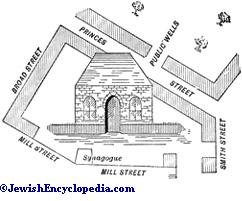
In the case of the party from Brazil, their advent was at once signalized by legal proceedings against them: they had made themselves jointly responsible to the officers of the vessel for the passage-money of each, and several of the party were unable to pay their fares, most probably because they had been despoiled of their effects before arrival. The municipal authorities, on the application of the captain, found themselves compelled to direct the imprisonment of two of the number, after the sale of the effects of the party, until the money due had been paid. In these proceedings reference was made to remittances which some of the party shortly expected from Holland, while some had already paid their own passage-money and were required by agreement to pay for others; so it is not fair to infer that all these arrivals were indigent. While these cases were still pending another party of Jews, of greater means, arrived from Holland. These proceedings, and probably personal bigotry and irascibility, led Peter Stuyvesant, the Dutch governor of New Netherlands, to order them to leave the colony, in which course he was abetted by some of his associates. But before these orderscould be executed instructions of a liberal character from the directors of the Dutch West Indies Company arrived, superseding local orders against the Jews. Stuyvesant's ire may have been again aroused by the report that more Jews were expected shortly from Holland, who would "then build here a synagogue." Under date of April 26, 1655, the directors of the Dutch West Indies Company instructed Stuyvesant that the prohibition of Jewish settlement recommended by him "would be unreasonable and unfair, especially because of the considerable losses sustained by the Jews in the taking of Brazil, and also because of the large amount of capital which they have invested in shares of this company. . . . They shall have permission to sail to and trade in New Netherlands and to live and remain there, provided the poor among them shall not become a burden to the company or the community, but be supported by their own nation."
Stuyvesant vouchsafed only a grudging assent to these instructions, and declined to permit one of these early Jewish settlers, Salvator d'Andrade, to purchase a house and lot in New Amsterdam, curtailed the right of Abraham de Lucena and others to send goods for purposes of trade to the Delaware River, and levied a special military tax on Jewish settlers, despite their protests, in Aug., 1655, Jews not being permitted to mount guard with other citizens. Further Jewish appeals to the directors at home resulted in a vigorous reproof of Stuyvesant coupled with more specific directions in favor of Jewish settlers, expressly providing that they should enjoy all the civil and political rights in New Netherlands which were accorded them in Amsterdam, and including express authorization to acquire real estate and to trade in the adjacent district. The specific limitations upon their rights contained in these instructions were fraught with important consequences, however, and should be noted:
"Jews or Portuguese people, however, shall not be employed in any public service (to which they are neither admitted in this city), nor allowed to have open retail shops; but they may quietly and peacefully carry on their business as beforesaid and exercise in all quietness their religion within their houses, for which end they must without doubt endeavor to build their houses close together in a convenient place on one or the other side of New Amsterdam—at their choice—as they have done here."
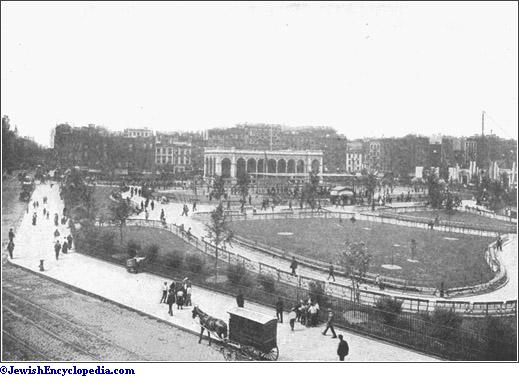
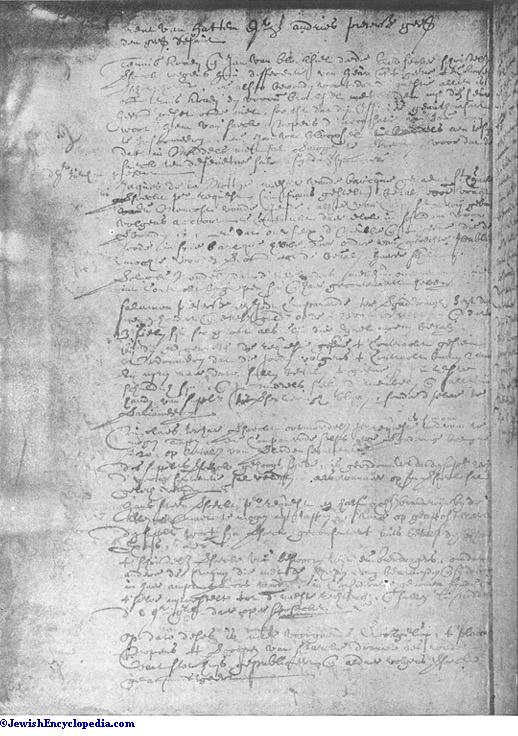
The prohibition against engaging in retail trade compelled Jewish residents to direct their energies particularly to foreign and intercolonial trade, which resulted in pecuniary profit not merely to themselves, but also to the whole colony, for they were peculiarly well situated for opening such commercial intercourse with their brethren, scattered all over the world, having common ties of language, blood, and mutual confidence, and dealing in the most varied articles. Jews were accordingly the pioneers of this trade in New Netherlands, and continued throughout the whole colonial period to be among the most prominent importers and exporters. So far as the establishment of a ghetto is concerned, there is no reason to believe that this provision was ever enforced, and Jews resided at will throughout the territorial limits. The provision concerning their religious worship did not forbid the private practise of their rites, but only the public establishment of a synagogue, which had been the particular grievance of the local authorities. The consequence is that the origin of the religious gatherings of the little community is shrouded in darkness, though indications are that private religious worship began about 1654, immediately after their arrival.
That the settlers joined in efforts to observe the ceremonies of their faith from the date of their arrival is certain, for it is known that in July, 1655, they applied to the municipal authorities for a grant of land for a burying-ground, which application was refused on the ground that there was no present need for it. The need soon arose, however, and on July 14, 1656, a lot was granted them "for a place of interment," apparently without charge, the site of which Judge Daly shows was on New Bowery, near Oliver street, and which the Jewish community augmented by the purchase of adjoining tracts in 1681, 1729, and 1755. The oldest decipherable inscription on the tombstones in this cemetery is that of Benjamin Bueno de Mesquita, dated 1683, one Joseph Bueno, presumably of the same family, having purchased the tract acquired in 1681.
In 1657 one of these early settlers, Asser Levy, applied for the burgher right, which was essential to the carrying on of certain vocations, and showed that he had exercised such right in Amsterdam, but he found that it was necessary to appeal to the director-general and council before an order (April 26, 1657) admitting Jews to citizenship was obtained, the municipal authorities having denied the application. A few days before this determination on appeal, an application of one Jacob Cohen-Hendricus, "to bake and sell bread within this city, as other bakers, but with closed doors," was denied by the Court of Burgo-masters as contrary to the privileges granted to the burghers by the director-general and council, and against the orders of the lord mayors. Whether this determination was reversed by the Asser Levy decision admitting Jews to burgher rights, or was persisted in, so that the baking and selling of bread were regarded as one of the fields of retail trade closed to the Jews under the instructions from the directors of the company, can not be definitely determined.
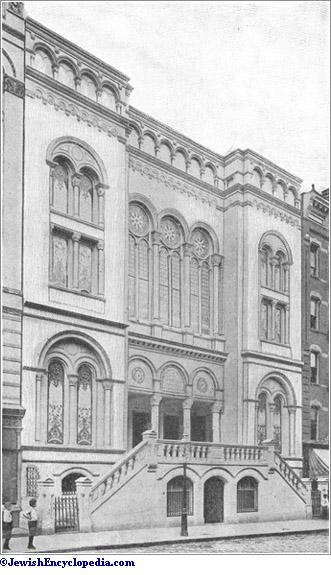
By this time the Jews had acquired definite and valuable rights, even though somewhat restricted, and the municipal authorities began to treat them liberally. Thus, on June 3, 1658, the Court of Burgomasters, apparently on its own initiative, declined to permit judgment in civil actions to be taken against Jacob Barsimson, a Jew, holding that "though defendant is absent, yet no default is entered against him, as he was summonedon his Sabbath": an instance of religious toleration and just dealing foreshadowing a New York statute of two centuries later that made it a misdemeanor maliciously to serve any one with process on his Sabbath, or with process returnable on that day ("New York Penal Code," § 271). Similarly, the municipal authorities licensed Asser Levy and Moses Lucena, Oct., 1660, as sworn butchers, providing on their application that they might take the oath at the hands of the officer "agreeably to the oath of the Jews," and with the reservation that they should not be bound to kill any hogs.
English Period (1664-1776):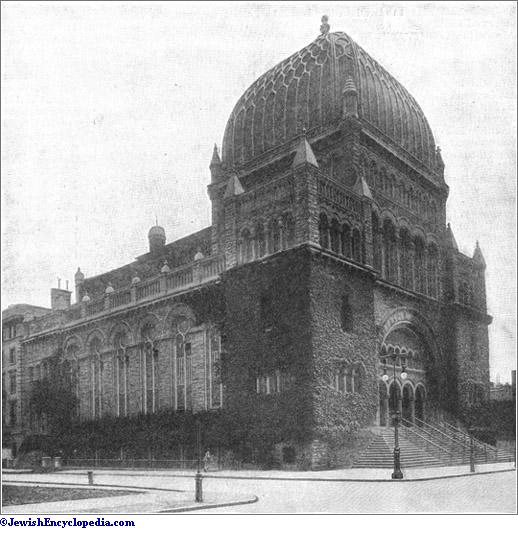
Charles II. having granted New York to his brother James, subsequently James II., the fleet sent out in 1664 under Colonel Nicholls succeeded in seizing the colony; the articles of capitulation guaranteed to all residents the rights of free denizens, and all their property rights, and provided that the Dutch there should enjoy liberty of conscience. It was apparently because of these terms, confirmed by the Treaty of Breda in 1667, that Jewish residents under the new order continued in their established rights, although the same effects result from the principle of English law that conquered territory continues to be governed by its former laws, except in so far as expressly changed by law. As governor, Nicholls, in 1665, promulgated the "Duke's Laws," which contained a clause safeguarding religious rights, but which, in terms, referred only to persons "who profess Christianity." Governor Andros' instructions of 1674 were not so limited, and in an official report in 1678 he refers to the presence of some Jews in the colony. Governor Dongan's first instructions again contained the limitation, and in 1683 the Colonial Assembly adopted a charter of liberties which also was limited, in its clause as to immunity from religious persecution, to persons"who professed faith in God by Jesus Christ," though this clause was purely negative.
The Synagogue.In 1685 two determinations were reached concerning the Jews, both antagonistic; one concerned the application of Saul Brown to trade at retail, which was denied, though he was permitted to engage in wholesale trade with the governor's consent; the other ruling, made by the mayor and common council on the application of the Jews for liberty to exercise their religion, was to the effect "that no public worship is tolerated by Act of Assembly but to those that profess faith in Christ, and therefore the Jews' worship is not to be allowed." It will be observed that this ruling is limited to "public" worship, and is based upon the local act of assembly, and Judge Daly suggests that Governor Dongan, who was a liberal and enlightened man, may have taken advantage of the absence of such limitation in his second set of instructions, in 1686, and have authorized public Jewish worship. Some form of semiprivate Jewish "separate meetings" already existed, and are referred to in Dominie Selyn's report to the Dutch classis in 1682; and Chaplain John Miller's map of New York in 1695 shows a Jews' synagogue on the south side of Beaver street, near Mill street, recording also that Saul Brown (a name derived from "Morenu") was its minister, and that the congregation comprised twenty families. By 1700 the site of the synagogue was so well known that in a conveyance of certain premises the latter were described as adjoining a place "now commonly known by the name of the Jews' Synagogue." Moreover, the public authorities even extended exemption from civil and military service to the ministers of the Jewish congregation, as appears from a petition of Abraham de Lucena to Governor Hunter dated Sept. 13, 1710, praying for similar immunities in consideration of his ministerial functions and referring to the enjoyment of such privileges by his predecessors. This date, however, almost comes within the period of existing official records of the Congregation Shearith Israel, of New York, whose minutes begin in 1729 and refer to an earlier constitution of 1706. This congregation dedicated a synagogue on Mill street in 1730, on a lot purchased two years previously, and for many years thereafter its synagogue, which followed the Sephardic ritual, was the only one in the United States: the synagogue was remodeled and reconsecrated in the year 1818.
Not Allowed to Vote for Assembly.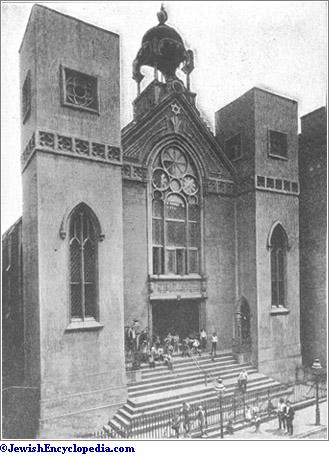
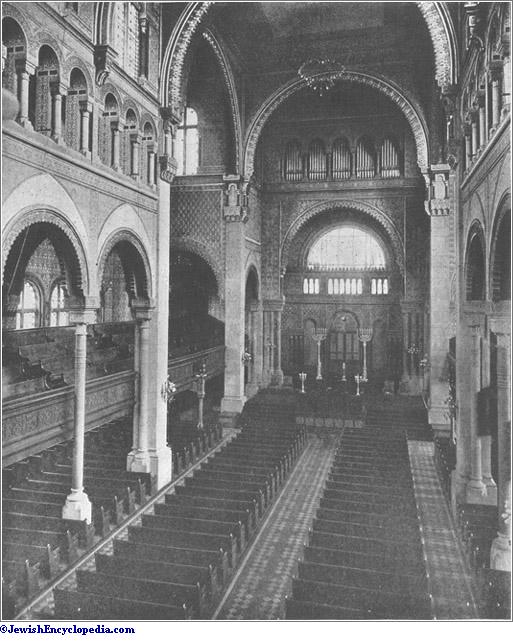
By the commencement of the eighteenth century, therefore, the last curtailment of religious rights of the Jewish settlers in New York had disappeared; of their political rights only a single abridgment is recorded during the eighteenth century, and that is connected with a bitter political contest of the year 1737. In that year the General Assembly, at the instance of a shrewd lawyer representing one of the contestants, decided that Jews ought not to be admitted to vote for representatives in this colony, as they enjoyed no such rights in England with respect to voting for members of Parliament; and in the course of the same controversy the assembly further decided that they should not be admitted as witnesses. Even the former determination is of doubtful correctness, for the law of England concerning elections to Parliament did not control; but the ruling that Jews were incompetent as witnesses was inconsistent with colonial precedents, and would have been most serious and dangerous in its consequences had it been generally followed: the context shows, however, that the witnesses under consideration were electors testifying as to their votes in the recent election, so the ruling was, apparently, merely a corollary to the finding that they could not lawfully vote for representatives. Gov. Seward referred to the minutes recording this determination as a "spot which the friends of rational liberty would wish to see effaced."
A poll-list of the election for the General Assembly of 1761 has been handed down, and the names of several Jews are found entered as voters in that year in the city. The prohibition against Jews engaging in retail trade seems to have become obsolete by this time, and the Declaration of Independence and the religious clauses of the first state constitution of 1777, in establishing complete religious liberty, merely continued as a matter of law rights of absolute equality already enjoyed in practise by the Jews in New York, though there do not seem to have been any Jewish incumbents of public office in civil life prior to the adoption of these great charters of public liberty.
Commercial Activity.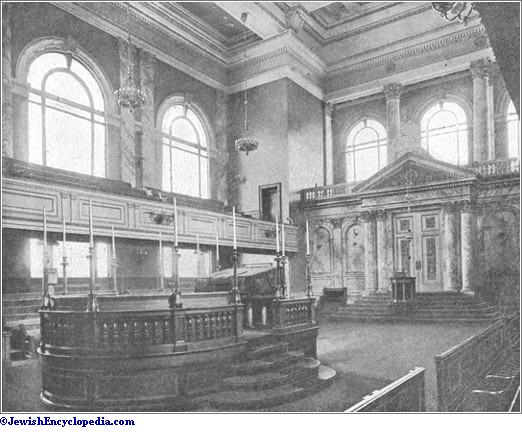
The commercial activities of the Jews of New York were very varied. During the first few decades after their settlement they engaged in trade with the West Indies (particularly Curaçao, St. Thomas, and Jamaica), along the Hudson and Delaware rivers, with Rhode Island, and with Africa, England, Holland, the Madeiras, and Portugal. A bill of lading of jewelry shipped from Curaçao to New Netherlands, dated 1658, a Jew being the importer, has been preserved, as also even earlier references to Jewish importers of tobacco in New York. Under date of 1720 there is mention of the expected arrival in New York of the slave-ship of Simon the Jew, hailing from Guinea. Jews were engaged in exporting wheat from New York on a very large scale about 1710, Lewis Gomez and his family being the principal dealers, and Abraham de Lucena being associated with them in a considerable branch of this business. For several decades the Gomez family seem to have been the most influential Jewish residents. Joseph Bueno was a prominent broker in New York even before the close of the seventeenth century, and it was with particular reference to his services to the governor, Lord Bellomont, that that dignitary wrote to the Board of Trade in 1700, concerning matters of colonial finance, that "were it not for one Dutch merchant and two or three Jews that have let me have money I should have been undone." In 1705 a petition concerning the fixing of the fair standard values of foreign coins, signed by sixty-six of the most prominent merchants of New York, bore the signatures of Joseph Bueno,Abraham de Lucena, and Samuel Levy. Sampson Simson was a member of a delegation of eight appointed to receive the charter of the New York Chamber of Commerce from Lieutenant-Governor Colden in 1770, and some years later (1792) Benjamin Seixas and Ephraim Hart appear among the founders of the New York Stock Exchange.
The Couty Appeal.In 1672 one Rabba Couty of New York, whose ship "The Trial" had been seized and declared forfeited by the courts in Jamaica on the theory that he was an alien within the meaning of the Navigation Act, though he was admittedly a Jewish burgher of New York, secured a reversal of this decree in England on appeal to the Council for Trade; this decision is of great importance, not merely as recognizing the Jews as British subjects, but because it seems to be the first case in which efficacy was allowed to colonial grants of naturalization.
During the French and Indian war Jacob Franks of New York was the provision agent for the crown to the British forces in America, he having been associated with a British syndicate, consisting of Colebrook, Nesbitt, and Franks, whose dealings with the crown during this period exceeded £750,000: the Franks family was one of the leading ones in the New York Jewish community of the eighteenth century. Hayman Levy of New York, the employer of John Jacob Astor, was very largely engaged in the fur trade with the Indians shortly before the American Revolution; and the commercial dealings of Sampson and Judah Simson were also very extensive.

An incident illustrative of the generosity of the early New York Jewish community and of its friendly relations with other communions was brought to light when a subscription-list for raising funds for building a steeple for Trinity Church in 1711 was discovered; it contains a separate list, entitled "The Jews' Contributions," aggregating £5 12s. 3d. from seven subscribers, including the rabbi, De Lucena, the total amount subscribed being £312.
Shearith Israel.The cosmopolitan character of the Jewish population of New York from early times is indicated by anarticle written by a local Christian clergyman, the Rev. John Sharpe, in 1712, who refers to there being Jewish residents of New York at that day from Poland, Hungary, Germany, etc. In fact, in 1784, a majority of the electors of the Shearith Israel congregation, more commonly known as the Spanish and Portuguese synagogue, were Ashkenazim, not Sephardim. After the date of this congregation's purchase of land for its synagogue in Mill street, 1728, there are records giving the names of its successive ministers and lay officials; at the time of the consecration of the synagogue in 1730 Moses Gomez, son of Lewis Gomez, was president, his father having acted in that capacity at the time the land was purchased; Moses Lopez de Fonseca was then rabbi. The name of Joseph Jessurun Pinto, who officiated as rabbi from 1759 to 1766, is identified with the earliest New York religious publication devoted to Jewish interests handed down to us—a form of prayer for a Thanksgiving Dayservice appointed in 1760 to celebrate the English conquest of Canada. This was published in the same year in an English translation.
In 1766 a book of prayers for the holy days, according to the order of the Spanish and Portuguese Jews, and translated into English by Isaac Pinto, was published in New York; the translator of this work was a relative of the rabbi just referred to. It is of special interest not merely because it was probably the first Jewish book published in New York, but because its publication was forbidden by the synagogal authorities in London, who were opposed to anything tending to establish the reading of Jewish prayers in the vernacular. Such tendencies as these probably gave rise to the society Mezion Teza Torah, established in connection with this synagogue in 1731 for the purpose of perpetuating the old ritual. The old entries in the congregational minutes show that the elaborate system, to which were attached the penalties of fines, reprimands, and possible expulsion, employed in Amsterdam and London to secure conformity with the ceremonial laws, was continued in New York. An increase in the number of violations of the dietary laws resulted in the adoption of a by-law in 1758 providing for the expulsion of persons eating "ṭerefah" or breaking the Sabbath. In 1729 the annual expenses of the congregation aggregated only £91; by 1746 they had risen to £268, the congregation having then fifty-one members, each of whom originally undertook to contribute £2 per annum; but as this did not suffice, assessments based on individual fortunes were levied, which gave way to the present purchase and rental of pews system, supplemented by voluntary contributions. Connected with the congregation was a school, which at first held sessions every afternoon, but in 1746 held both morning and afternoon sessions. The English branches of study as well as sectarian instruction constituted the curriculum, and provision was made for the free instruction of poor children; so that this school is remarkable as at the same time one of the oldest and one of the most comprehensive in the colony. The Jewish community directed the administration of its charities exclusively through congregational channels until the commencement of the nineteenth century, its "ẓedaḳah" (charity) fund being originally under the sole administration of its president, though in 1756 the rules were amended to forbid his disbursement of over £20 for charity without the consent of the board of trustees. An interesting contemporary account of the Jewish community of New York in 1748, from the pen of the Swedish naturalist Peter Kalm, has been preserved, which includes a description of divine service in the synagogue: "There are many Jews settled in New York, who possess great privileges. They have a synagogue and houses, and great country-seats of their own property, and are allowed to keep shops in town. They have likewise several ships which they freight and send out with their own goods. In fine, they enjoy all the privileges common to the other inhabitants of this town and province."
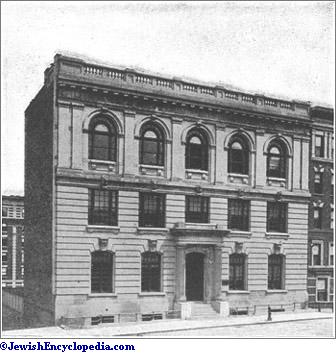
Jews eagerly availed themselves of all possible opportunities to acquire citizenship in New York,as in the Dutch period, when they as eagerly sought burgher rights, after their claim to the privilege had been established. During the English period numerous arrivals secured from the governors letters of denization and licenses to trade and traffic. A number of years, however, before Parliament passed the act of 1740, permitting foreign Jews to be naturalized in the colonies, the New York Colonial Assembly freely passed special acts, first applicable to individuals only, then general in character, permitting Jews to be naturalized without including in their oath the words "upon the true faith of a Christian." A large number of Jews in New York availed themselves of this opportunity under the colonial and the parliamentary statutes, including at least one Jew from the colony of Rhode Island, to whom that privilege had been denied by the courts of his colony under a forced and unreasonable construction of the British act of 1740. Until the Revolutionary war the Jewish immigrants came principally from Spain, Portugal, and the West Indies, while there was an appreciable migration to Rhode Island and Pennsylvania shortly before the end of the English period. Further shrinkage was due to defections toward Christianity through intermarriage, and the ratio of Jewish to non-Jewish population decreased considerably during the period from 1750 to 1812, chiefly because of the immense non-Jewish immigration.
Revolutionary Period: Gershom Mendez Seixas.As regards the Revolutionary struggle, Jewish names are found subscribed to the non-importation agreements, that of 1769 containing the names of Samuel Judah, Hayman Levy, Jacob Moses, Jacob Myers, and Jonas Phillips. Benjamin Seixas was an officer in Colonel Lasher's battalion as early as 1775, and Isaac (subsequently Colonel) Franks joined the same regiment the next year. Numerous other Jewish names from New York appear on the Revolutionary rolls, some as officers. Particularly striking was the attitude of the Jewish congregation as such; for, on the eve of the British occupancy of New York, an overwhelming majority resolved to abandon the city and the synagogue. Rabbi Gershom Mendez Seixas, whose patriotism found unmistakable expression, was in the van. Most of the members of the Jewish community took refuge in Philadelphia during the Revolution, and assisted in the erection of the synagogue of the Congregation Mickvé Israel, but a majority of its members returned to New York at the close of the war.
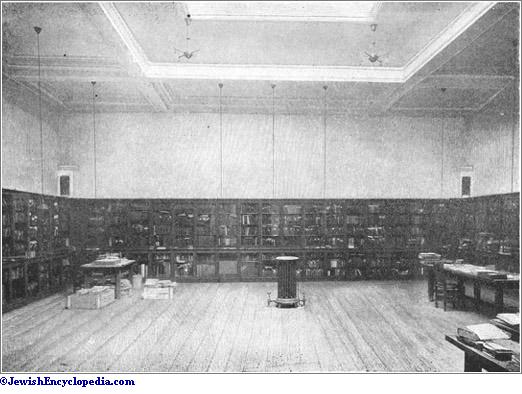
During the struggle the services of Isaac Moses, who, with Robert Morris, afforded material financial assistance to the colonial cause, proved particularly valuable. There was, however, a sprinkling of Tories in the New York Jewry during the Revolution, some of whom occasionally held services in the synagogue during the British occupation, underthe presidency of Lyon Jonas, and subsequently of Alexander Zuntz, a Hessian officer who settled in New York. On the reorganization of the congregation at the close of the Revolution Hayman Levy succeeded Alexander Zuntz as president, and the congregation presented an address of congratulation to Governor Clinton on the outcome of the war. G. M. Seixas was one of the fourteen ministers who participated in the inaugural exercises of Washington's administration in New York on April 30, 1789, Col. David S. Franks being one of the marshals in charge of the procession. Gershom Mendez Seixas became rabbi of the Congregation Shearith Israel in New York in 1766, and remained in the rabbinate until his death in 1816. He became a trustee of Columbia College by legislative appointment under the Act of the Legislature reorganizing the college, and thus evidencing its non-sectarian character, in 1787, and continued to hold that office till he resigned in 1815. A Thanksgiving Day sermon which he preached on Nov. 26, 1789, was printed at the time, and a notice of this publication described it as "the first of the kind ever preached in English in this state." Of course, synagogal preaching in those days was very unusual, and Dr. Daniel L. M. Peixotto took part in a public discourse delivered and then printed in New York in 1830, referring to the fact that this task had been theretofore performed only at intervals, he at the same time paying tribute to his own father's services (Rev. M. L. Peixotto) as Seixas' successor, in delivering occasional discourses on moral and religious subjects. The New York congregation was one of several Jewish congregations which joined in an "Address of Congratulation" to Washington in 1790; the text of this address, as well as Washington's reply, is still extant. A list of the affluent residents of New York in 1799, showing the names of all whose residences were assessed at £2,000 or over, includes the names of Benjamin Seixas, Solomon Sampson, Alexander Zuntz, and Ephraim Hart.
Beginnings of Charity Organization.The community was somewhat depleted by the loss of those who had settled permanently in Philadelphia, but on the other hand it received slight accessions from Newport, R. I., during and after the Revolution, as that city never recovered from the injuries it received at the hands of the British during the Revolution. But, as already stated, even at the commencement of the War of 1812 there were not more than about 500 Jews resident in New York. The close of this period marked the commencement of the movement for the organization of independent Jewish charities, at first under congregational auspices; subsequently these became more and more numerous, and were, for the most part, absolutely independent. In 1785 the Hebra Gemilut Hasadim, for burying the dead, was organized; it is still (1904) in existence. In 1801 Myer Polonies bequeathed to the congregation $900 for the foundation of a free denominational school, and with this fund, subsequently augmented, the Polonies Talmud Thora was soon after founded. In 1802 the Hebra Hased Ve' Amet, now probably the oldest Jewish charitable society in the United States, was organized, for visiting the sick and attendance at funerals. In 1805 a new cemetery in what is now 11th street was consecrated by the Shearith Israel congregation.
From 1812 to 1881: Hendricks and Noah.The military rolls of the War of 1812 contain the names of several Jewish soldiers from New York, but possibly more important was the subscription of $40,000 by Harmon Hendricks of New York toward the loan of $16,000,000 called for by Congress, but which was very difficult to raise. Hendricks' father and grandfather had been residents of New York; it was chiefly through his management of a large metal business that the family had become the wealthiest and most influential in the city at this date. Soon after this war the Shearith Israel congregation enlarged and rebuilt its synagogue on Mill street, the new edifice being consecrated in 1818. In the course of the address delivered on that occasion by Mordecai M. Noah the fact is referred to that increasing immigration from Europe had made this enlargement necessary; this address was printed in pamphlet form and aroused considerable attention, evoking appreciative letters concerning the American Jews from Jefferson, Madison, and John Adams. Noah, at this time and until his death in 1851, was the most prominent member of New York's Jewish community. Besides his activity in communal affairs and as editor of influential local newspapers, he held important public offices, having been appointed United States Consul to Tunis in 1816; elected Sheriff of New York in 1821; appointed Surveyor of the Port (1829-33), and judge of the Court of General Sessions in 1841. His famous "Ararat Project" of 1825, for establishing a Jewish colony for the persecuted Jews of Europe, on Grand Island, near Niagara Falls, under his direction as "Judge of Israel," attracted general attention to America throughout the Jewries of the world.
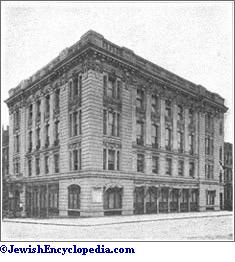
At this period Mordecai Myers was one of the representatives of New York in the State Assembly (1829, 1831, 1832, and 1834). The first Jewish memberof the bar was Sampson Simson, admitted in 1802; he was also the first Jewish graduate of Columbia College, and he became one of the chief leaders in Jewish charitable work in New York. lorenzo da Ponte, by birth a Jew, was professor of Italian language and literature at Columbia College from 1826 to 1837; he introduced Italian opera into America, and as the librettist of Mozart's "Don Giovanni" and "Marriage of Figaro" and the author of numerous essays, poems, etc., deservedly occupied a leading place in American literary and art circles. John Howard Payne of New York, the author of "Home, Sweet Home," was the son of a Jewish mother. Among the actors and dramatists who became well known to the theater-going public during the first half of the nineteenth century, besides Mordecai M. Noah, were Aaron J. Phillips, Moses S. Phillips, Emanuel Judah, Samuel B. H. Judah, and Jonas B. Phillips; the last-named was assistant district attorney for many years. Samuel B. H. Judah's "Gotham and the Gothamites," published anonymously in 1823, aroused much attention at the time.
New Influx; New Synagogues.The increase in Jewish immigration was now becoming more and more marked. The reactionary measures following upon Napoleon's downfall were particularly potent causes of Jewish immigration, especially from Germany. The volume of this immigration as well as the nationalities represented in it can be conveniently studied in the number and the character of new Jewish congregations formed in the city. The Congregation B'nai Jeshurun was the second congregation formed; it was organized in 1825, and was composed of German, English, and Polish Jews who preferred the Polish ritual to the Spanish and Portuguese form used by the Shearith Israel congregation. Several German congregations were next formed in rapid succession: the Anshe Chesed congregation (organized about 1830), the Congregation Shaar Hashomayim (1841), and the Rodof Sholom congregation (1842). Another congregation, employing the Polish minhag, had meanwhile been constituted (1839) under the name of Shaaray Tsedek.
An interesting account of services in the Crosby Street Synagogue in 1841, which had been consecrated by the Shearith Israel congregation in 1834 and took the place of the old Mill street building, was published by L. Maria Child in her "Letters from New York," and then she adds:
"Last week, a new synagogue was consecrated in Attorney street, making, I believe, five Jewish synagogues in this city, comprising in all about ten thousand of this ancient people. The congregation of the new synagogue are German emigrants, driven from Bavaria, the Duchy of Baden, etc., by oppressive laws. One of these laws forbade Jews to marry; and among the emigrants were many betrothed couples, who married as soon as they landed on our shores, trusting their future support to the God of Jacob. If not as 'rich as Jews,' they are now most of them doing well in the world; and one of the first proofs they gave of prosperity was the erection of a place of worship."

Prosperity, however, was a relative term, for the members of the first German congregation, Anshe Chesed, which was merged in 1874 with the Congregation Adas Jeshurum (organized in 1868), forming the Congregation Temple Beth-El, now worshiping at Fifth avenue and 76th street, were so poor at the time of organization, about 1830, that they held services in a small room, each member, on wintry Friday evenings, bringing with him a piece of wood to aid in maintaining a fire. Even in 1846, when this was one of three German congregations that united to elect Max Lilienthal as chief rabbi, their combined resources enabled them to pay only a salary of $1,000 per year to their rabbi, who describedthis as the first Jewish "ministership" (preacher as distinguished from ḥazzan) established in America. It was his practise to preach alternately at each synagogue, the members of the other two hastening to it just before the hour of preaching. In 1845 the German Reform Congregation Temple Emanu-El, the first avowedly Reform congregation in the city and since many years the wealthiest Jewish congregation in the country, now worshiping at Fifth avenue and 43d street, was organized, Dr. L. Merzbacher becoming its rabbi-preacher at a salary of $200 per annum.
The number of congregations continued to increase with rapidity, seven more being formed subsequent to the organization of Temple Emanu-El and prior to the close of the year 1850, which date may be treated as a convenient landmark: Shaaray Tefilla, organized in 1846, with the Polish ritual, as the result of asccession from the B'nai Jeshurun congregation (Rev. S. M. Isaacsbeing its first preacher and John I. Hart its president) and now worshiping in West 82d street; Beth Israel, formed in 1846, with the Polish ritual; Bene Israel, a Dutch congregation organized in 1847; Ahawath Chesed, a Bohemian congregation organized in 1848, and now merged in the Congregation Ahawath Chesed Shaar Hashomayim, worshiping at Lexington avenue and 55th street; Shaare Rachamim and Bichur Cholim, both organized in 1849, with the German ritual; and Beth Abraham, organized in 1850, with the Polish ritual. Accounts of these congregations, written by Dr. Max Lilienthal, I. M. Wise, J. J. Lyons, and J. J. Benjamin II., have been preserved, the last three being of later date.
Clergy and Press.The most prominent ministers of the New York Jewish community during this period were: Jacques J. Lyons (ḥazzan of the Shearith Israel congregation from 1839 to 1877), Samuel M. Isaacs (who became minister of the B'nai Jeshurun congregation on his arrival in America in 1839, but resigned in 1845 to accept the leadership of the Congregation Shaaray Tefillah, with which he remained until his death in 1878), M. Lilienthal (already referred to), Dr. M. J. Raphall (of the B'nai Jeshurun congregation from 1850 to 1868), and L. Merzbacher (of the Temple Emanu-El from 1845 to 1856).
The publication of Jewish weekly newspapers began in New York during this period, the earliest being the "Asmonean," edited by Robert Lyons (published from 1849 to 1858); the "Jewish Messenger" (1857 to 1902) was edited by Samuel M. Isaacs (later assisted by his sons, Myer S., Isaac S., and Abram S. Isaacs), and "Israel's Herold" (1849), in German, by Isidor Busch. The little periodical called "The Jew" (1823-25) devoted itself to answering Christian missionary arguments, conversion societies being particularly active at this period.
Hebrew Benevolent Societies.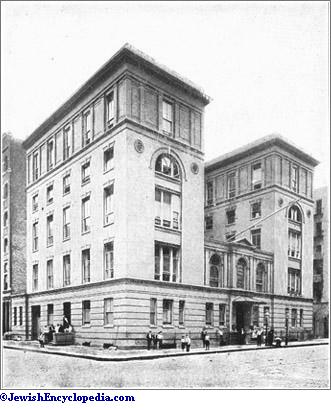
Numerous small Jewish charitable societies sprang up during this period; often half a dozen different societies were identified with a single congregation. Before one of these, The Society for the Education of Orphan Children and the Relief of Indigent Persons, identified with the Spanish and Portuguese synagogue, an address was delivered in 1830 by Daniel L. M. Peixotto, the vice-president of the Medical Society of the City and County of New York, which address was printed in pamphlet form and attracted considerable attention. Most important of all these early charitable societies were two which were subsequently (1859) merged to form the Hebrew Benevolent and Orphan Asylum Society, whose asylum has been located on Amsterdam avenue, between 136th and 138th streets, since 1884. The earlier of these two societies, the Hebrew Benevolent Society, was organized in 1822, with the residue of a fund raised by private subscription two years previously for the maintenance of a poor Jewish veteran of the Revolution. Its first president was Daniel Jackson; his successorswere Morland Micholl, Elias L. Phillips, Mordecai M. Noah (1842 to 1851), Harris Aaronson (1851-57), and Phillip J. Joachimson. In 1845 the other constituent society, the German Hebrew Benevolent Society, was formed, Henry Keyser being its first president. Judge Joachimson continued to serve as president of the consolidated societies under their new name; in 1861 Joseph Seligman became president; and he was in turn succeeded by Benjamin I. Hart, Samuel M. Cohen, Joseph Fatman, Myer Stern, Jesse Seligman, Emanuel Lehman, and Louis Stern. For many years both of the constituent societies celebrated the anniversaries of their founding by holding dinners, at which a large portion of their year's income was collected, after addresses, often notable, by prominent Christian and Jewish speakers, had been delivered.
The Damascus blood accusations of 1840 shocked the whole civilized world, and the Jews of America held public meetings of protest and demanded international intervention, which was promptly undertaken by the American government; the New York community was the first in America to take up the matter, its forcible appeal to President Van Buren bearing the signatures of I. B. Kursheedt, chairman, and Theodore J. Seixas, secretary.
Opening of Official Careers.During the Mexican war the Jews of New York contributed considerably more than their quota to the American army and navy. Particular reference should be made to Uriah P. Levy, commonly known as Commodore Levy, who was ranking officer of the United States navy at the time of his death in 1862 (and whose munificent charitable bequests were lost to the country by a successful contest of his will), and to his brother, Captain Jonas P. Levy, who also was prominent in communal affairs. In 1833 Francis H. Goldsmid of London was able to point, as an argument in favor of the removal of Jewish disabilities in Great Britain, to the number of Jews who had held political office in America; the New York names antedating this period have already been enumerated.
Curiously enough, the "Beau Brummel" of New York society during this period, Henry Caroll Marks, better known as "Dandy" Marks, was the son of a Jewish father. Bernard Hart was honorary secretary of the New York Stock Exchange from 1831 to 1853, succeeding Jacob Isaacs. August Belmont, who came to New York in 1837 as the representative of the Rothschilds, was for many years consul-general for Austria and United States minister at The Hague, and was subsequently chairman of the Democratic National Committee for many years, but he did not identify himself with Jewish affairs; previously the New York firm of J. L. & S. I. Joseph had represented the Rothschilds in America.
Almost all the Jewish immigrants to America during the period under consideration arrived wholly without means, and for many of them peddling was at first their only means of livelihood. With remarkable industry, skill, and determination they set out, and the result of a few years of effort was a competency for most of them, frequently, after some years, the amassing of considerable wealth. In their efforts at self-improvement, the intellectual side was not overlooked; hence schools and lodges were freely created and patronized by them, and the results are indicated by such suggestive observations as that of Francis Lieber to Bluntschli, the publicist, in a private letter written in 1869: "The German Jews in America gain in influence daily, being rich, intelligent, and educated, or at least seeking education. They read better books than the rest of the Germans, the booksellers tell me." At the time of the organization of Temple Emanu-El, in 1845, however, in the language of a contemporary correspondent of the "Allgemeine Zeitung des Judenthums" who was identified with that body," thirty-one thirty-seconds of the members of the New York Jewry were uncouth and illiterate." Contemporary records bear witness to the fact that the quality of the immigrants improved considerably for some years after 1848, political as distinguished from merely economic causes underlying the increasing immigration. Besides those already referred to, the following names should be added as particularly prominent in the history of New York communal affairs just before 1850: Walter, Dittenhoefer, Moses, Content, Lehmaier, Seligman, Stettheimer, and Bernheimer.
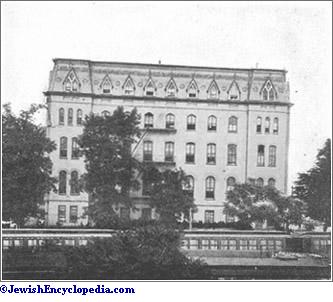
An appreciable number of the New York Jewry at this period being engaged in peddling, it had aconsiderable floating population, many Jews returning to town chiefly on the Jewish holy days. In 1847 Max Lilienthal estimated the Jewish population at 15,000. Efforts were made by him and Merzbacher to make the synagogue a means of intellectual as well as religious uplifting for the community. Lilienthal held confirmation exercises for the first time in America in his New York congregations in the year 1846, and projected various other reforms; but the reactionary tendencies proved too strong, and after a few years he relinquished his post and devoted himself to his educational institute, though he officiated in 1850 on the occasion of the consecration of the new synagogue erected by the Anshe Chesed congregation in Norfolk street. Merzbacher introduced confirmation at the Temple Emanu-El in 1848, and as the congregation had been formed on avowedly Reform principles, this and other innovations were received with favor by his congregation.
The Orders and the Schools.A bet din was established in New York in 1847, consisting of Lilienthal (president), Wise of Albany, Felsenheld, and Kohlmyer of New Orleans. Before the close of this period the Independent Order of B'nai B'rith had its beginnings, its first lodge being organized in New York in 1843; the Order of the Free Sons of Israel was established in 1849.
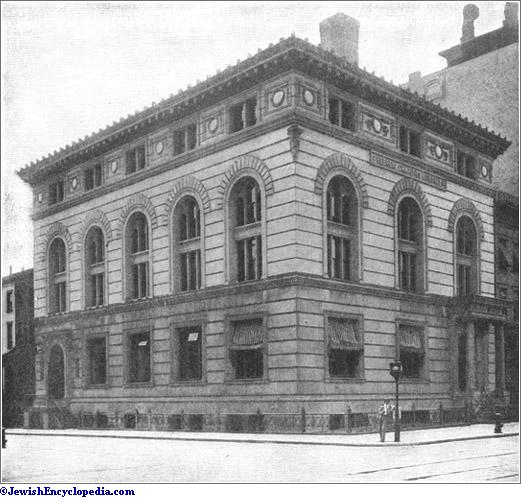
The agitation in favor of public education which took place before the close of this period exerted a most important influence on the community. The schools of the Public School Society were under denominational influences, and the demands, due to alien immigration, for increased state aid for schools under Catholic influences, were denied as a consequence of the prejudices due to the "Know-Nothing" period, while Jewish schools never shared in the public moneys which were appropriated. The result was that denominational schools for instruction in secular as well as religious branches were necessary,and these were organized by the various Jewish congregations. As a result of Governor Seward's agitation new unsectarian public schools were organized in New York under an act passed in 1842, and Jews before long joined non-Jews in enjoyment of the advantages of this leveling bulwark of democracy. Jewish religious schools have also been maintained in connection with the various congregations.
New Synagogues, 1850-80.From 1850 on the newly organized Jewish congregations in New York became far too numerous to permit of separate enumeration here. Among those organized during the decade ending in 1860 special reference should be made to the Beth Hamedrash Hagodol, formed in 1852, which has been characterized, though with doubtful accuracy, as the first Russian Jewish congregation in New York. In 1851 the Shaare Brocho, the first and at present (1904) the only French congregation in New York, was organized; the Congregation Adath Israel was organized in 1860. During the same period the Anshe Chesed congregation added to the number of American pulpit leaders Jonas Bondi, who became its rabbi in 1858 and was for many years editor of the "Hebrew Leader" (1859-74). He was succeeded as rabbi in 1865 by Moses Mielziner, later senior professor of the Hebrew Union College in Cincinnati, Ohio. Temple Emanu-El lost the services of Merzbacher by death in 1857, when Dr. Samuel Adler entered its rabbinate. The "up-town" movement, which has so completely changed the aspect of New York during the past few decades, was particularly marked in the Jewish community. On Sept. 12, 1860, the Spanish and Portuguese Congregation Shearith Israel consecrated a new synagogue in 19th street, in the place of the old Crosby street structure, and it furthermore secured the services of an associate preacher in the person of A. Fischell (1856-61). The adoption of a municipal ordinance in 1851 prohibiting further interments within the city south of 86th street immediately led various congregations to acquire lands for cemetery purposes on Long Island. The establishment of a Jewish hospital had been discussed for a number of years before Sampson Simson succeeded, in 1852, in organizing the society which has become familiar as the Mount Sinai Hospital; its name, until 1871, was "The Jews' Hospital." A building was erected, at the cost of $36,000, on land in West 28th street donated for that purpose by Mr. Simson, and it was dedicated in 1855. After Mr. Simson's death, in 1857, the fortunes of the hospital were presided over with particular ability by Benjamin Nathan. Mr. Simson's will made generous provision also for other Jewish charities.

The first Jewish orphan asylum in the city was opened in West 29th street, in 1860, by the consolidated societies referred to above and now known as the Hebrew Benevolent and Orphan Asylum Society. Both the hospital and the orphan asylum were among the recipients of the generous benefactions of the philanthropist Judah Touro of New Orleans, who died in 1854, and whose bequests made it possible to undertake muchcharitable work throughout the country. The Maimonides Library, established by the Independent Order of B'nai B'rith, opened its doors Oct. 22, 1851.
Board of Delegates.The discriminations against American Jewish citizens of which Switzerland was guilty in the early "fifties" aroused the New York Jewish community to vigorous action, Jonas P. Levy and Alexander Kursheedt being especially concerned in the movement. The community, in 1858, also adopted concerted measures to secure national intervention in connection with the Mortara affair, and this incident led the next year to the formation of the Board of Delegates of American Israelites, for securing and maintaining Jewish civil and religious rights at home and abroad, and in which New York influences were most prominent, though the organization was national in scope. Its first officers included Henry I. Hart, president; Gerson N. Hermann, treasurer (subsequently coroner); and Myer S. Isaacs, secretary—all of New York; and the activities of this body continued until it was merged in the Union of American Hebrew Congregations in 1878. The New York Jews who achieved political prominence during this decade include Emanuel B. Hart (member of Congress from 1851 to 1853, president of the Board of Aldermen of the city, and surveyor of the port during the Buchanan administration) and Isaac Phillips, who was appointed general appraiser by President Pierce and was also grand master of the masons of the state of New York.
During the Civil War.The next decade includes the period of the Civil war, when many more New York Jews served in the field than their numerical proportion demanded, no fewer than 1,996 Jewish names from New York being in Simon Wolf's lists in his "American Jew as Patriot, Soldier, and Citizen"; several Jews attained the rank of colonel. Jewish patriotism was conspicuous also in civil life. Thus, Joseph Seligman was one of the vice-presidents of the Union Square mass-meeting called in aid of the Union on April 20, 1861, during the Civil war, and his firm, J. & W. Seligman & Co., rendered the government signal service in maintaining its credit and floating its bonds, and was its fiscal agent for a long time. Rumor has it that President Grant offered the post of secretary of the treasury to Joseph Seligman. The New York Jewry also gave material aid to the Metropolitan Fair in aid of the United States Sanitary Commission in 1864. Michael Heilprin valiantly defended Judaism, in the columns of the "New York Tribune," early in 1861, against the charge of justifying slavery, brought by M. J. Raphall.
Among the early Republican antislavery workers in New York was A. J. Dittenhoefer, an elector on the Lincoln ticket in 1864 and who became judge of the marine court in New York (1862-64). During this period Jonas N. Phillips was president of the Board of Councilmen and acting mayor (1857); Joseph Koch was appointed civil justice (1869) and became later the first Jewish state senator of New York (1882-83). Albert Cardozo was elected justice of the Supreme Court in 1867, after having served as a judge of the Court of Common Pleas, but was one of the judges whom the reform element drove out of office at the time of Tweed's downfall (1871); one of the leaders in this reform movement was Simon Sterne of New York, secretary of the famous "Committee of Seventy," who subsequently became the father of the legislation in restraint of railroad-rate discriminations and of the Federal Interstate Commerce Act. Marcus Otterbourg became United States minister to Mexico about 1867, and subsequently was a police justice.
Hebrew Orphan Asylum.On Nov. 5, 1863, the Hebrew Benevolent and Orphan Asylum Society dedicated its orphan asylum in East 77th street, Benjamin I. Hart being its president at this time and Dr. Herman Baar its superintendent. Other Jewish charities were called into existence about the same time: the Hebrew Free School Association in 1864, on the initiative of the Rev. S. M. Isaacs and Hezekiah Kohn, Barnet L. Solomon becoming the first president; and the Purim Association in 1861, which for many years raised considerable sums of money for other Jewish charities.
The best evidence of the material progress of the New York community during this period is afforded by the fact that Temple Emanu-El, on dedicating its synagogue at Fifth avenue and 43d street on Sept. 11, 1868, secured $708,575 from its members on the sale by auction of 231½ pews, leaving a surplus of over $86,000 beyond the entire cost of the land and structure—a most remarkable contrast to its balance-sheet of 1846, at the end of the first year of its history, when its total receipts were $1,520.27. In 1865 the able administration of Lewis May as president of this congregation began, and continued during several decades; James K. Gutheim was chosen its associate English preacher in 1868. In 1866 the Reform congregation Adas Jeshurun, with a synagogue in West 39th street, was organized, David Einhorn, who had become the leader of the Reform movement in America soon after his arrival in Baltimore in 1854, being called to the rabbinate. The Shaaray Tefillah congregation dedicated a new synagogue in West 44th street in May, 1869, while the ranks of the Reform ministers were strengthened by the arrival of Adolph Huebsch, who became rabbi of the Ahawath Chesed congregation in 1866. Dr. S. Abrahams, who died in 1867, left bequests of rare magnitude for those days to the local Jewish charities.
Period 1870-1881.The year 1870 was signalized by the holding of a large Hebrew charity fair for the benefit of the Jews' Hospital and Orphan Asylum, $101,675.50 being realized—an enormous sum for that day. Owing to this addition to its funds, the Mount Sinai Hospital was enabled to erect, in 1872, a building at Lexington avenue and 66th street. Hyman Blum succeeded Emanuel B. Hart as president of this institution in 1879. The necessity for new charitable organizations made itself felt during the period under consideration. It called into existence in 1872 the institution known as the Home for Aged and Infirm Hebrews, though its beginnings can be traced farther back. The United Hebrew Charities was formed in 1874 for the purposeof administering extra-institutional relief, several other smaller societies being merged in it; for many years the name of Henry Rice has been identified with the splendid work of this organization as its president and latterly that of Dr. Lee K. Frankel as its superintendent. The Hebrew Sanitarium, having a summer home for poor Jewish children at Far Rockaway, Long Island, dates back to 1876, the Young Men's Hebrew Association to 1874, the Hebrew Sheltering Guardian Society to 1879 (Mrs. Priscilla J. Joachimsen, its founder, being its president from 1879 to 1893; succeeded by Morris Goodhart and, in 1897, by its present executive, Samuel D. Levy), and the Hebrew Technical School for Girls, under its former name, the Louis Down-Town Sabbath and Day School (in honor of its founder, Mrs. Minnie D. Louis), to 1880, Nathaniel Myers being now its president.
As to congregational activities, the Ahawath Chesed congregation, under Dr. Huebsch's guidance, consecrated its synagogue at Lexington avenue and 55th street in 1872. The Anshe Chesed congregation, after erecting a synagogue at Lexington avenue and 63d street (consecrated in 1873), consolidated the next year with the Adas Jeshurun congregation; the minister of the latter congregation, David Einhorn, took charge of the new organization, which took the name Congregation Temple Beth-El and worshiped in the new synagogue above referred to. Dr. Einhorn was succeeded in 1879 by his son-in-law, Kaufmann Kohler, who continued to minister to that congregation until 1903, maintaining its standing as one of the leading Reform congregations in the country; he was the first in New York to introduce Sunday services as supplementary to the Saturday services (1880). Another congregation, in 1876, assumed the name Anshe Chesed, which had been dropped in the amalgamation of the two congregations just named into Temple Beth-El; this congregation now worships in East 112th street. The Congregation Hand-in-Hand, formed about 1870, was incorporated in 1887 as Temple Israel of Harlem, of which for many years Maurice H. Harris has been rabbi and Daniel P. Hays president. The First Hungarian Congregation Ohab Zedek, now worshiping in Norfolk street, with Phillip Klein as rabbi, was founded in 1872. Gustav Gottheil was called to the pulpit of Temple Emanu-El in 1873, and Henry S. Jacobs to that of the Congregation Bnai Jeshurum in 1876. In 1871 F. de Sola Mendes became rabbi of Shaaray Tefillah, and his brother, H. Pereira Mendes, was called to the pulpit of the Spanish and Portuguese Synagogue in 1877.
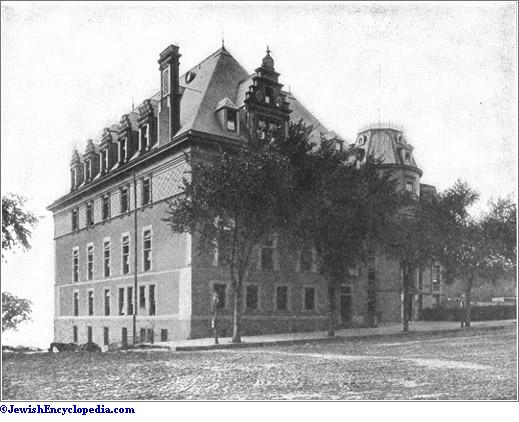
In 1876 the Society for Ethical Culture was founded by Felix Adler, with the motto "Deed, not Creed," and as it has been supported principallyby Jews it has detached many persons from their ancestral faith. It has organized valuable charitable and educational auxiliaries. The American Jewish Publication Society, founded in New York in 1872, ran a very brief course. In 1879 Philip Cowen, F. de Sola Mendes, and others founded the "American Hebrew," one of the leading Jewish weeklies printed in the United States.
Several Jews held responsible public offices between 1870 and 1881; Philip J. Joachimson was a justice of the marine court from 1870 to 1876, and Myer S. Isaacs in 1880; Moritz Ellinger, who edited the "Jewish Times" in New York from 1868 to 1880, was a coroner of the city, as was Gerson N. Hermann; Joseph Blumenthal served as a member of the New York assembly in 1874, and again for a term beginning in 1888; Leo C. Dessar and Jacob Hess served in the same assembly in 1875. After this date the list of New York Jews serving in the state legislature becomes too large to be given here, but it seems strange that forty years elapsed after Mordecai Myers' last term expired in 1834 before another Jew was elected to either branch of the legislature, and the relatively smaller activity of New York Jews in politics prior to the "eighties," as compared with those of the South, for instance, has been often commented upon. The early summer of 1877 was marked by the commencement of the form of social prejudice which makes itself felt by the attempted exclusion of Jews from summer hotels, and which has come to the surface ever since in many sections notwithstanding laws penalizing it. Its first marked exhibition was at the Grand Union Hotel at Saratoga, then managed by Judge Hilton on behalf of A. T. Stewart, and it was soon afterward taken up in various suburbs of New York, notwithstanding the indignant protests of cultured Christians and Jewish residents.
Statistics of the Jews of the United States were first carefully gathered about 1876 by the Board of Delegates of American Israelites and the Union of American Hebrew Congregations, and these represented the Jewish population of New York city in 1878 as 60,000. By the year 1881, when Russian persecutions began to drive thousands of Jews every year to America, the Jews of New York had become important factors in almost every branch of commercial and professional life and were maintaining a system of charities unequaled by those of any other communion of the city, though the percentage of those requiring charitable aid was very small.
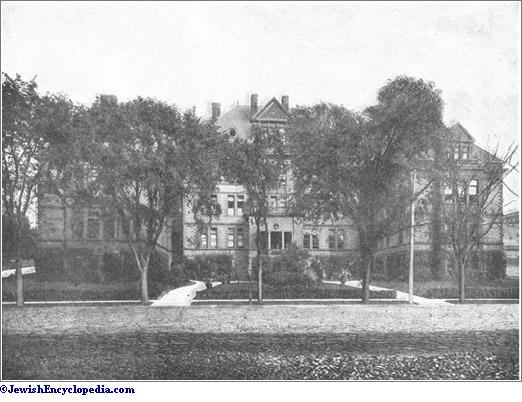
The stream of Russian immigration, which began to assume very large proportions in 1881, has, at least numerically, entirely transformed New York Jewry. Before that year the percentage of Jews from Russia and Poland resident in New York was quite small. The enormous increase of the Jewish population of the citysince that date is to be accounted for principally by emigration from those countries, and nearly all the newcomers have had to begin at the bottom of the ladder. Serious problems have thus been presented by the need of relieving the distress incident to this increase and of providing means of livelihood for the unprepared; and the problem of educating and Americanizing them has proved equally serious. These have been met with remarkable success, notwithstanding the development of congested districts in the lower east side of the city, where the Jewish population is densest, as also in other sections of the city, in Harlem and Brownsville. While some of the new-comers have already attained considerable commercial success, the large majority of them have swelled the ranks of the humblest wage-earners.
Early in the course of the Russian persecutions a mass-meeting of New York's most representative citizens was held at Chickering Hall Feb. 1, 1882, at the call of ex-President Grant and other prominent Christians, to express sympathy with the persecuted Jews in the Russian empire; Mayor Grace presided, and ex-Secretary of State Evarts and other distinguished speakers delivered addresses. But it was recognized that assistance at home, and not mere protests against Russia's course, was needed. The emergency called forth a princely gift to the community from Jacob H. Schiff, whose name thereafter became widely known in connection with the philanthropic activities of the New York community. In 1882 some oppressive prosecutions of New York Jews for violations of the Sunday laws, notwithstanding their observance of Saturday as their Sabbath, led to a judicial decision by Judge Arnoux to the effect that existing statutes exempting persons who observed another day as Sabbath from the operation of certain of these laws were of doubtful constitutionality (and constituted mere defenses, while not preventing prosecutions), but this narrow construction of the law has not prevailed. In Nov., 1883, the Hebrew Technical Institute was organized; James H. Hoffman was the first president of this institution; he was succeeded, at his death, by Joseph B. Bloomingdale.
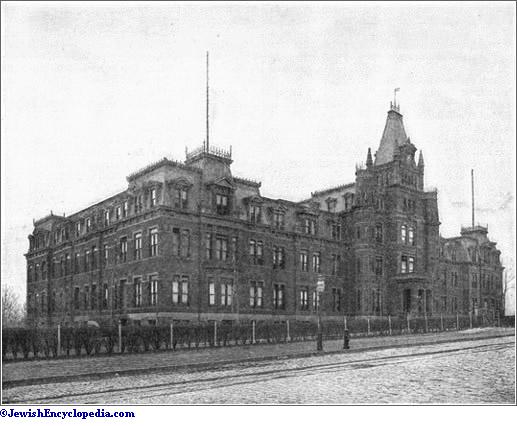
The New York Jewry joined in the celebration of the centenary of Sir Moses Montefiore in 1884, its principal memento of the occasion being the foundation, in that year, of the Montefiore Home for Chronic Invalids; Henry S. Allen was the first president of the society, but he was soon afterward succeeded by Jacob H. Schiff. A fair held in 1886 in aid of this institution realized $158,090.11, and this enabled the society to erect itspresent building (1888), which since has been enlarged. In 1884 the building of the Hebrew Benevolent and Orphan Asylum Society, referred to above, was dedicated, Jesse Seligman being its president at the time. The necessity of raising funds with which to develop the educational work required in the lower East Side led to another fair in 1889, which realized about $125,000; this was used in the erection of the Hebrew Institute building, at Jefferson street and East Broadway, which was completed in 1891. The Aguilar Library, which had branches in various sections of the city, but which was recently merged in the New York Public Library, was founded in 1886. In the same year the Jewish Theological Seminary was established in New York.
As regards congregational activity, many of the hundreds of Orthodox congregations established in the lower section of the city were founded soon after the immigration of 1882 began. Of the larger congregations, the B'nai Jeshurun consecrated its new synagogue at Madison avenue and 65th street in 1884; the Congregation Bnee Scholom, in East 5th street, was formed in Dec., 1885; and the Congregation Zichron Ephraim, worshiping in 67th street, was organized in 1889, with Dr. Bernard Drachman as rabbi. Dr. Joseph Silverman was elected associate rabbi of Temple Emanu-El in 1888, and soon afterward instituted supplementary Sunday services there; and before the end of that decade Maurice H. Harris and Rudolph Grossman became ministers of Temple Israel and Beth-El respectively, Grossman being associate minister to Kaufmann Kohler. In 1889 the Emanu-El Sisterhood was founded by Gustav Gottheil, with the idea of securing personal service in charitable fields from the ladies of that congregation, and the other congregations thereafter formed similar organizations, which together comprise the Federation of Sisterhoods (Mrs. William Eisenstein, president) and share in the work of the United Hebrew Charities.
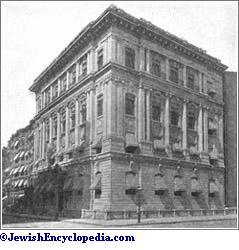
The Russian Jewish persecutions stimulated into action the genius of Emma Lazarus, Judaism's most distinguished American writer. In 1886 Benjamin F. Peixotto, who had been United States consul-general to Rumania, founded the "Menorah" (a monthly); and in 1882 the "Hebrew Standard" was founded. In the field of politics New York Jews were more active during this decade than ever before. Adolph L. Sanger was elected president of the Board of Aldermen in 1885, Samuel A. Lewis in 1874, and Theodore W. Myers comptroller of the city in 1887. Oscar S. Straus served as United States minister to Turkey from 1887 to 1890 and from 1897 to 1900, and was thereafter appointed member of the Permanent International Board of Arbitration at The Hague, in succession to ex-President Harrison. Edwin Einstein served as a member of Congress from New York city from 1879 to 1881, and Simon M. Ehrlich, Joseph E. Newburger, Sampson Lachman, Joseph Koch, Henry M. Goldfogle, Leo C. Dessar, and Joseph H. Stiner served as judges in the minor courts of the city.
1891-1904.A decade after the commencement of the inrush of Russian immigration the necessity of organized relief along charitable and educational lines became even more marked than previously. In 1890 the Beth Israel Hospital was founded, and three years later the Lebanon Hospital opened its doors, both of them, the former in particular, being created largely through the efforts of recent Russian immigrants in aid of their poorer fellow countrymen. The same observation applies also to the Hebrew Gemilath Chassodim (Free Loan Association), founded in 1892. The demands upon the Hebrew Institute became daily more pressing, and accordingly a fair in aid of that institution as well as of the Hebrew Technical Institute was arranged in 1895, which realized approximately $100,000. The Hebrew Institute, reorganized in 1893, with Isidor Straus as president, under the name of the Educational Alliance, became a wonderfully effective agency in the Americanization of the Russian Jews of the lower East Side. The Brightside Day Nursery was founded in 1894 to care for the infants of wage-earning women of the same vicinity during the mothers' working hours, and the Hebrew Infant Asylum was chartered in April, 1895.
Jewish Theological Seminary.Philanthropists abroad, about this time, began to realize that the problem of caring for the hundreds of thousands of needy Jews thrown upon New York's resources through bigotry and persecution was not the concern of the New York Jewry alone, and accordingly the Baron and Baroness de Hirsch came nobly forward and assumed part of the burden. In 1891 the former founded the Baron de Hirsch Fund with an initial endowment of $2,500,000, Myer S. Isaacs being the president of its trustees from that date until his death in 1904. In 1897 the widowed Baroness Clara de Hirsch erected a Home for Working Girls in New York at a cost of $200,000, attaching to it an endowment of $600,000. In May, 1900, the Young Men's Hebrew Association dedicated a building at Lexington avenue and 92d street which had been given it by Jacob H. Schiff. In celebration of his seventieth birthday Solomon Loeb (the father-in-law of Jacob H. Schiff) erected the United Hebrew Charities building at Second avenue and 21st street (May, 1899). In May, 1901, the Bedford County Sanitarium of the Montefiore Home was completed. March 13, 1904, the new buildings ofthe Mount Sinai Hospital in Madison avenue (between 100th and 101st streets) were dedicated; over $1,500,000 was raised for its building fund; for a number of years Isaac Wallach has been its president. April 26, 1903, the building of the Jewish Theological Seminary in West 123d street was erected, Jacob H. Schiff providing for its cost; Solomon Schechter, who had been called to that post from Cambridge, England, the year before, being the president of the seminary. The Jewish Theological Seminary is the reorganized New York Seminary, referred to above, for which an endowment fund of over $500,000 was secured by individual subscription. In the death of Leonard Lewisohn March 5, 1902, the New York community lost one of its most generous members; his brother Adolph Lewisohn, through such gifts as $125,000 to the Hebrew Technical Institute (1903), $75,000 to the Hebrew Technical School for Girls (a year earlier), and about $250,000 to Columbia University for the erection of a building for the School of Mines (1904), entered the same category. James Loeb subscribed $500,000 toward the foundation and endowment of a new conservatory of music, and Joseph Pulitzer gave $1,000,000 to endow a school of journalism in Columbia University. Meyer Guggenheim and sons, Henry L. Einstein, Abraham Steinam, the children of Meyer Lehman, and scores of others who might be mentioned if space permitted have all made munificent gifts on single occasions to charity.
Ministerial Changes.The congregational activity of the New York community during the period under review remains to be chronicled. Temple Beth-El dedicated its synagogue at Fifth avenue and 76th street in 1891; in 1899 Dr. Samuel Schulman became associate minister of that congregation, and sole officiating minister in 1903, on Kaufmann Kohler's accession to the presidency of Hebrew Union College in Cincinnati. The Congregation Shaaray Tefillah erected a new synagogue in West 82d street in 1893, and the Shearith Israel congregation consecrated its new edifice at Central Park West and 70th street on May 19, 1897. The Rodef Sholom congregation purchased the synagogue at Lexington avenue and 63d street from the Temple Beth-El in 1891, and has since worshiped there, first under Aaron Wise, then under Rudolph Grossman; the Congregation Ahawath Chesed elected Dr. Alexander Kohut as successor to Huebsch in 1884, and on his death May, 1894, D. Davidson, whose successor was Dr. Isaac S. Moses.
Joseph M. Asher became rabbi of the B'nai Jeshurun congregation in succession to Stephen S. Wise, who had succeeded Henry S. Jacobs. In 1894 the Congregation Agudath Jesharim, East 86th street, was organized, with A. Calman as rabbi. The persecutions of the Jews in Rumania sent a large number of Rumanian Jews to New York, beginning about 1899, though the first Rumanian-American congregation had been organized in New York in 1885. The removal "up-town" of large numbers of Jews who had formerly lived on the lower East Side led to the formation of a number of Jewish congregations in Harlem, the Congregation Chaari Zedek of Harlem, in West 118th street, for instance, being organized by former members of the Chaari Zedek congregation in Henry street; L. Zinsler became their rabbi. In 1892 the Council of Jewish Women was formed, as an outcome of the Parliament of Religious held in connection with the Chicago World's Fair; its largest section exists in New York.
It would, of course, be quite impossible, even in a large tome, to give an exhaustive enumeration of the numerous Jewish congregations and charitable societies of New York city, and the limits of an article like this make it necessary to consider only some of the most important ones. Dr. David Blaustein, the superintendent of the Educational Alliance, speaking before the National Conference of Jewish Charities at a meeting in New York in May, 1904, said of the section of the city south of Houston street and east of the Bowery that it contained 5,897 tenements, in which lived 64,268 families, having 84 different occupations; it contained 306 synagogues and only 22 churches. Besides its 48 public schools, it contained 307 ḥadarim attended by 8,616 boys and 361 girls. It maintained four Jewish theaters. He estimated that over $1,000,000 a year is spent for charitable purposes by the Jewish inhabitants of this section. Mr. Jacob A. Riis, who may well be described as one of the best-informed students of this district, says in his work entitled "A Ten Years' War," concerning the blocks of tenements inhabited by poor Jews of this section:
Academic Positions."The poorer they are, the higher rent do they pay, and the more do they crowd to make it up between them. They brought nothing, neither money nor artisan skill—nothing but their consuming energy—to our land, and their one gift was their greatest offense. And yet, if ever there was material for citizenship, this Jew is such material. Alone of all our immigrants he comes to us without a past. He has no country to renounce, no ties to forget. . . . He is not always choice in method; he often offends. But he succeeds. He is the yeast of any slum if given time. If it will not let him go, it must rise with him. . . . I, for one, am a firm believer in this Jew and in his boy. Ignorant they are, but with a thirst for knowledge that surmounts any barrier. The boy takes all the prizes in the school." As to the Jew in the sweat-shop, Riis says: "He had to do something, and he took to the clothes-makers' trade as that which was most quickly learned. The increasing crowds, the tenement, and his grinding poverty made the soil, wherein the evil thing grew rank. The Jew is the victim of the mischief quite as much as he has helped it on."
In New York educational institutions many Jews are teachers and principals, while special reference should be made to Henry M. Leipziger, supervisor of public-school lectures; Julia Richman, district superintend-' ent of schools; and Edwin R. A. Seligman, Morris Loeb, Adolph Werner, Richard Gottheil, Adolphe Cohn, A. S. Isaacs, Alice Isaacs, H. Jacoby, and Abraham Jacobi, who hold academic. positions in the higher educational institutions of New York. Annie Nathan Meyer was one of the founders of Barnard College. Among leaders in university circles of a few decades previous were George J. Adler, of German dictionary fame; I. Nordheimer, the Orientalist; and Selig Newman, the Hebraist. Heinrich Conried, as executive head of the Metropolitan Opera House, may be specially referred to as one of many notable instances of Jewish activity in musical and dramatic circles in New York. Several widely read newspapers, dailyand weekly, published in Yiddish, are maintained in New York.
Recent Events.The Tenement House Commission appointed by the legislature of 1894 devoted itself very largely to the phenomena of overcrowding in Jewish tenements, and improved conditions somewhat by securing the enactment of legislation which led to the tearing down of some of the worst of these structures. The overcrowded conditions in this section gave rise to a considerable amount of vice and (on the part of a conspicuous few who enjoyed police protection) crime; as a result, in 1901 the issue of "protection for the homes" became an important one in the mayoralty campaign of that year, in which Seth Low was elected, largely because the East Side had been aroused to the need of protecting its homes; Isidor Straus, as president of the Educational Alliance, and M. Warley Platzek were particularly prominent among the Jews who were working for these reforms. The funeral of Chief Rabbi Jacob Joseph, who had become chief rabbi of a number of Russian Jewish congregations in 1886, gave rise to a riot in the streets of New York on July 20, 1902; this riot, however, was quite unpremeditated, and was chiefly an outbreak of mischievousness provoked by the unwonted spectacle of thousands of aliens participating in the funeral procession with unwonted demonstrative signs of grief. The police protection afforded had been inadequate; and the mayor promptly appointed a committee to investigate the riot; administrative changes were made, various police officers were disciplined, and the principal rioters were promptly punished by the criminal courts. Many New York Jews served as volunteers in the Spanish-American war.
In connection with the Kishinef massacres several huge mass-meetings were held in New York, the principal one, at Carnegie Hall (May 27, 1903), being presided over by Mayor Seth Low and addressed by ex-President Cleveland; the plan of petitioning the czar through the diplomatic officers of the United States, which was espoused by President Roosevelt, originated with Leo N. Levi of New York, president of the Independent Order B'nai B'rith.
Organized efforts have been made, with the cooperation of charitable organizations in other sections of the country, to relieve the congestion in the most crowded portions of the city, and a "removal office" has been opened to that end. Indigence and overcrowding have naturally caused an increase of crime among the Jews of New York, and a society to aid Jewish prisoners, and a Jewish Protectorate Association, have been organized, though until recent times the conspicuously clean record in this respect of the Jews of New York was frequently commented upon.
Numerous Zionist organizations have been formed in New York. Jewish social clubs of all kinds exist in New York, some having luxurious club-houses of their own.
In Public Life.
The great numerical increase of the New York Jewish community led to various efforts to form organizations of Jewish voters, but these designs have been successfully thwarted, and it has been repeatedly demonstrated that normally there is no "solid Jewish vote," and that the Jewish voters are quite fairly distributed among the various political parties. The number of Jews coming to the front in public life, however, increases with the growth of Jewish population and with longer residence in, and fuller identification with the interests of, the city. New York had among its representatives in the Constitutional Convention of 1894 Edward Lauterbach, Louis Marshall, Joseph J. Green, Jacob Marks, Aaron Herzberg, and M. Warley Platzek, the two first-named being influential in framing the important charity and judiciary articles respectively of that convention. In the same year Nathan Straus, whose activity in providing pure Pasteurized milk for the children of New York and other cities deserves mention here, refused the nomination for mayor of the city tendered by the Tammany Hall organization. His brother, Isidor Straus, was elected a member of Congress early in the same year; during the periodunder consideration Jefferson M. Levy, Henry M. Goldfogle, and Montague Lessler also were elected to Congress. Randolph Guggenheimer served as president of the Municipal Council of New York from 1898 to 1902, Jacob A. Cantor (previously leader of the Democratic party in the state senate) as president of the Borough of Manhattan; Nathaniel Elsberg has been one of the leaders of his party in the state Senate for the last six years; and Mitchell L. Erlanger was elected sheriff of New York county in 1903. Judicial positions on the Supreme Court bench were occupied during this period by W. N. Cohen (1897), David Leventritt (1899), Samuel Greenbaum (1901), and Alfred Steckler. J. E. Newburger is a Judge of the Court of General Sessions, while E. A. Jacob, Stiner, Hoffman, Leon Sanders, Herman Joseph, and Julius M. Mayer have sat in minor courts. The last-mentioned was elected attorney-general of the state in 1904.
While New York unquestionably contains more Jewish inhabitants than any other city in the world, this has not been the case very long, though Jewish settlements took place there, under the Dutch administration, earlier than in any other city within the present limits of the United States. Thus, while the first two hundred years in the history of New York are important, particularly in connection with the evolution of the conditions fundamental to the present New York Jewry, it was reserved for the last half-century to create the distinctive numerical and economic conditions characterizing the Jewish community of New York city at the present day.
Appreciable Jewish migration to New York began in 1654, but as late as 1826 the Jewish population was approximately only 950, out of an estimated total Jewish population in the United States of 6,000 (Gilman, quoting Isaac Harby, in the "North American Review," 1826, p. 73). This total was reached from approximately half that number in about 1812, when, according to a contemporary New York estimate, the total Jewish population of the United States was only 3,000 (" Publications Am. Jew. Hist. Soc." vi. 141, 143; ix. 96). In 1841 the New York Jewry contained a population of about 10,000, having distanced Charleston, S. C., very soon after 1826, in which year the Jewish population of that city is supposed to have slightly exceeded that of New York. It was soon after this date, largely in consequence of the European revolutionary ferments of 1848, that German Jewish migration increased in geometric progression.
- Daly, Settlement of the Jews in North America;
- Publications Am. Jew. Hist. Soc.;
- American Jewish Year Book;
- Greenleaf, History of the Churches of All Denominations in the City of New York;
- Markens, The Hebrews in America;
- Dr. M. Lilienthal, in Allg. Zeit. des Jud. 1846-48;
- L. Maria Child, Letters from New York;
- Lyons and De Sola, A Jewish Calendar for Fifty Years;
- J. J. Benjamin II., Drei Jahre in Amerika;
- Statistics of the Jews of the United States, Compiled Under the Authority of the Board of Delegates of American Israelites and the Union of American Hebrew Congregations;
- Official Souvenir Book of the Fair in Aid of the Educational Alliance and Hebrew Technical Institute;
- Richard Wheatley, The Jews in New York, in The Century Magazine, Jan. and Feb., 1892;
- The Judœans, 1897-99;
- Hannah Adams, History of the Jews;
- Frank Moss, The American Metropolis;
- Hutchins Hapgood, Spirit of the Ghetto;
- Reminiscences by Isaac M. Wise (edited by David Philipson);
- Cahan, The Russian Jew in America, in Atlantic Monthly, July, 1898;
- Simon Wolf, The American Jew as Patriot, Soldier, and Citizen;
- Myer Stern, History of Temple Emanu-El;
- Henry S. Morais, Eminent Israelites of the Nineteenth Century;
- David Philipson, The Progress of the Jewish Reform Movement in the United States, in J. Q. R. Oct., 1897;
- J. H. Connelly, Charities of the Hebrews of New York;
- Jacob A. Riis, The Ten Years' War;
- idem, The Battle with the Slums;
- The Jews of New York, in Review of Reviews (1896), xiii. 58;
- M. Fishberg, The Russian Jew in America, ib. (1902) xxvi. 315;
- idem, Health and Sanitation of the Immigrant Jewish Population of New York, in The Menorah (1902), vol. xxxiii.;
- Wilson, Memorial History of New York;
- Publications of the New York Historical Society;
- Records of New Amsterdam (edited by B. Fernow);
- Isaac Leeser, The Jews, in Rupp's Churches of America;
- The Occident;
- Jewish Messenger;
- Jewish Times;
- The New Era;
- The American Hebrew;
- Works on the Churches of New York, Jewish, in Bulletin of the New York Public Library, vol. v., May, 1901;
- Documents Relating to the Colonial History of the State of New York.
There is reason for regarding as conservative the estimate of Joseph Jacobs, giving a population of 672,000. All immigrants are recorded and examined at Ellis Island, and since Oct. 1, 1884, the United Hebrew Charities, through its representatives there, has kept complete statistics of arrivals, their intended destination, and their nationality, sex, etc. From these statistics it appears that between the date named and June 30, 1904, there arrived by steamship 694,172 Jewish immigrants, of whom 504,181 were bound for New York.
Of the number arriving at Canadian ports and reaching New York overland there is no means of forming an estimate, but that it is not inconsiderable may be inferred from the facts brought out by the British Royal Commission on Alien Immigration and the debate in the House of Commons. It transpired that the majority of aliens arriving at English ports were on their way to America, and that a large proportion of these went through Canadian ports; that half of them went to New York may fairly be assumed. In 1880 the census taken by the Union of American Hebrew Congregations disclosed a Jewish population of 60,000. These, with the 500,000 reported by the United Hebrew Charities, with the immigration by way of Canada, with the number arriving between 1880 and 1884 (which years saw the first large immigration from Russia and probably brought 60,000 Jews to New York), and with the natural increase in all these groups, leave the estimate of 672,000 under rather than over the real number. Of the five boroughs which constitute the city, Richmond and Queens have only a few thousand each; Brooklyn has about 100,000; and the boroughs of Bronx and Manhattan, forming the old city of New York, have the remainder. In the Borough of Bronx there are about 50,000, and in Manhattan something over 500,000 in a total population in that borough of about 2,000,000.
Distribution.In Manhattan about 100,000, being the old residents with their natural increase and accretions, are scattered throughout the borough. About 50,000 are in the Harlem section bounded on the south and north respectively by 100th and 120th streets, and on the east and west by Second and Lenox avenues—in all a territory of about one-half a square mile. Most of these formerly lived on the lower East Side, but the growing congestion and their own improving material condition induced them to remove to this section. They represent a community with no wealthy members, but without an excessive number of very poor.
United Hebrew Charities.The section known as the lower East Side is approximately bounded by Madison street on the south, Houston street on the north, the Bowery on the west, and the East River on the east, and covers a territory about one square mile in extent. Within this square mile live 350,000 Jews—some of them under conditions of overcrowding impossible to describe. In May, 1904, David Blaustein, superintendent of the Educational Alliance, took a census of the district and found 64,268 families; at five persons per family, this would give a total of over 320,000. As many of these families keep one or more boarders, consisting of single men, or of married men whose families are still in Europe, it is evident that the total for the section must be rather more than 350,000. Necessarily, with so large a population in so small a territory, there must be an overwhelming proportion of poor. While the vast majority is normally self-supporting, the excess of income over minimum expenditure is so meager that any untoward circumstance will turn the scale: protracted sickness on the part of any member of the family, or brief sickness on the part of the bread-winner; commercial depression, or a strike or lockout, will cause temporary dependence. Hence it is that the United Hebrew Charities is so frequently called upon—in ten years it has dealt with 70,000 individual cases, each involving on an average about four persons per case. In all but an insignificant number of instances the relief required was only of a temporary nature. Of the 10,334 applicants, representing 43,938 individuals, who appeared at the United Hebrew Charities in the past fiscal year (1904) only 35 (or one-third of 1 per cent) had applied for assistance prior to 1889, while 5,525, representing 19,957 individuals, had never before applied. The expenditures of the United Hebrew Charities in the past year (1904), including cost of administration, were $228,000. Of this amount over $41,000 was granted to 570 pensioners (chiefly aged persons or women whose children have not yet reached the earning age), leaving for administration and general relief $187,000 to 44,000 persons, or about $4 per capita per annum. That the money is not expended upon permanent dependents is conclusively shown by these figures.
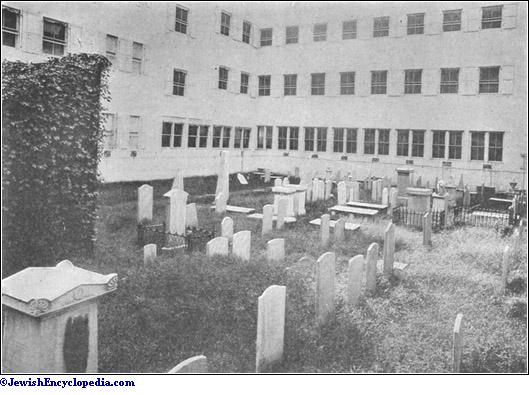
The United Hebrew Charities is housed at Second avenue and 21st street, in the Hebrew Charities Building, erected for it and for similar organizations that require office-room there, by Solomon Loeb. In addition to furnishing temporary relief in money or supplies and caring for its pensioners, the Charities maintains a workroom in which women with children to support are instructed in the use of the sewing-machine and are paid during the period of instruction. It retains a physician and nurses, who not only care for the consumptive in his home, but teach him how to live so as to endanger his family to the least possible extent; and it administers a Self-Support Fund with sufficient liberality to establish many recipients in business and make them self-supporting. The organization publishes a monthly magazine entitled "Jewish Charity," devoted to the consideration of all questions of a philanthropic nature. For several years attempts were made to secure, in the work of the United Hebrew Charities, a closer cooperation on the part of the East Side community, and in the early part of the year 1904 two subordinate organizations were established—District No. 1 in East Broadway, and District No. 2 in Ludlow street. All applicants for relief residing in these districts are referred to them, and the entire administration of the two districts is in the hands of persons residing in them, the funds being provided by the parent organization.
Allied with the Charities and aiding it in investigation and relief is the Federation of Sisterhoods, composed of fifteen organizations of women connected for the most part with the various leading congregations. The Sisterhood of Temple Emanu-El, the first organized, has its own home at 318 East 82d street, where, in addition to aiding the poor, it conducts an employment bureau. Other organizations have their own homes, and support, besides, classes of various kinds in the lower part of the city.
Asylums for Children.The Hebrew Benevolent and Orphan Asylum Society no longer engages in general relief-work. Instead it makes an annual appropriation of $25,000 or $30,000 to the United Hebrew Charities, which becomes its almoner. It confines its own activities to the 1,003 orphans committed to or taken under its charge. For those placed in its care by the city authorities it receives from the city treasury $104 per annum per capita. In the last fiscal year it received in this way $94,500; its expenditures were $200,000. The orphanage of the society is situated in Amsterdam avenue (between 136th and 138th streets). The society administers a fund of $100,000 given it by Emanuel Lehman to enable graduates of the institution to acquire trades or professions. An institution somewhat similar to it, but not confining its work to orphans, is the Hebrew Sheltering Guardian Society, situated at Grand Boulevard and 150th street, where 650 homeless children are cared for. The amount expended by it in the last fiscal year was $106,000, to which the city of New York contributed $69,000. The care of children under five years of age is entrusted to the Hebrew Infant Asylum, situated at 909 Eagle avenue, Borough of Bronx, which has charge of 151 children. It expended in the last fiscal year $31,000, toward which the city of New York contributed $16,000.
Aged Poor and the Hospitals.The helpless old are as well cared for as the helpless young. At 125 West 105th street the Home for Aged and Infirm Hebrews provides a refuge for 236 men and women at an expenditure, in 1903, of $42,000. Similar in character is the Home for the Aged at 40 Gouverneur street, on the East Side, maintained by the Daughters of Jacob, and having accommodations for about 20 persons. Another home for the aged is maintained at 210 Madison street by the Hachnoseth Orchim Society, which also cares for and houses friendless immigrants at the time of their arrival in New York. It will soon occupy a more commodious establishment at 229 and 231 East Broadway. Like the home of the Daughters of Jacob, this is maintained and conducted almost exclusively by residents of the East Side.
Another institution similarly maintained and conducted is Beth Israel Hospital at Jefferson and Cherry streets. This is a modern and completely equipped hospital and dispensary with 100 beds, which gave treatment last year to 867 patients at an expenditure of $25,600, of which the city of New York contributed $6,900.
Lebanon Hospital, at Westchester avenue and 150th street, Borough of The Bronx, treated in the last fiscal year 2,000 patients at an expense of $65,000, toward which the city treasury contributed $14,000. In 1903, in cooperation with the United Hebrew Charities, it established a convalescent home in which patients discharged either from its own or a sister hospital and not yet sufficiently recovered to proceed with their daily toil may remain the week or fortnight necessary to regain full strength.
The largest, most modern, and most complete of the communal institutions is Mount Sinai Hospital, covering with its dispensary and training-school for nurses an entire block (between 100th and 101st streets and Fifth and Madison avenues). These buildings were dedicated and occupied in the spring of 1904. During the past fiscal year, when the hospital had not yet taken possession of its new quarters, it treated 3,540 patients at an expenditure of $152,000, the city contributing $29,500.
Montefiore Home.The Montefiore Home cares for those who, by reason of the protracted or incurable nature of their illness, can not be admitted to the ordinary hospitals. Its building is in Broadway, between 138th and 139th streets; one of its departments is given to a thorough system of hydropathy under the supervision of Dr. Simon Baruch. A few years ago the directors of the Montefiore Home established at Bedford, Westchester County, N. Y., a sanatorium where sufferers in the early stages of consumption are cared for. That the need for the Montefiore Home is far greater than its capacity is shown by the fact that while 466 patients were admitted during the past fiscal year, 831 applicants were refused admission for lack of room. The total number of patients treated during the year (466 being admitted during the year and 385 being carried over from the previous year) was 851, the total cost being $141,000, of which about $50,000 was expended at the country sanatorium and the remainder at the city home.
The Sanitarium for Hebrew Children maintains a summer home at Rockaway Park, L. I., and during the summer it takes parties of mothers and children from the tenement-houses to its seashore place. About 20,000 annually are so benefited at a cost of about $20,000.
The Jewish Working Girls' Vacation Society maintains two summer homes, one at Bellport, L. I., and the other at Big Indian, N. Y., where working girls are enabled to spend a fortnight each at a nominal charge, the difference between the amount so taken and the actual cost being made up by the society.
Apart from societies connected with congregations, the foregoing list practically covers the more important organizations dealing with the physical side of the problem confronting the New York community. There are, in addition, such institutions as the Nurses' Settlement, whose excellent work under the leadership of Lillian D. Wald makes it a model for settlement workers. It is not entirely Jewish in its management or support, although its work is chiefly among the Jews of the East Side. So, too, with the Maternity Hospital and with Saint Mark's Hospital; the management of these is entirely non-Jewish, but by reason of the location of the institutions their beneficiaries are largely Jews.
Education.Secular education is cared for both through private channels and by the great public-school system, ranging from the kindergarten to the collegiate training of the College of the City of New York (for boys) and the Normal College (for girls). To such an extent do the Jews avail themselves of the public schools that the rosters of the public high schools and the City College show a Jewish attendance vastly in excess of the ratio of Jewish population: at the latter more than 75 per cent of the students are Jews. Probably because the public schools are so well attended, the number of private schools giving both secular and Jewish training is very limited. The provisions generally for religious education are not adequate. On the East Side religious education is largely imparted through the ḥeder. There are nearly 400 ḥadarim holding daily sessions, and it is estimated that they cost about $120,000 per annum to maintain. The Talmud Torah schools, of which the Machzikei, with 1,000 pupils, at 225 East Broadway, is the most important, meet daily. The Hebrew free schools (for the past few years under the management of the Educational Alliance) insure religious education for about 2,800 children, of whom about 80 per cent are girls.
Religious Instruction.In the older community religious education is mainly, though not exclusively, confined to that given in the Sunday-schools attached to the congregations. These have, with some exceptions, one session weekly. In addition to the Sunday-school which each congregation conducts for the children of its own members, many of the leading congregations maintain similar schools for the children of the poor. These schools are usually established away from the synagogue and in the neighborhoods which they are intended to benefit.

The lack of well-qualified religious teachers prompted the management of the Jewish TheologicalSeminary of America to establish a class for the training of teachers (1903). The seminary's library of Judaica—a large part of which is the gift of Mayer Sulzberger—is one of the most valuable in the world and is preserved in a fire-proof room constructed for the purpose. Here also are kept the records of the American Jewish Historical Society.
Educational Alliance.There is, aside from religious teaching, a varied and great educational activity. The Educational Alliance, with a daily attendance of nearly 7,000, is located at East Broadway and Jefferson street, and is the active center. In addition to its Hebrew free schools, carried on partly in the main building and partly in Branch A, at 624 East 5th street, it conducts classes for immigrants (formerly carried on by the Baron de Hirsch Fund), where 450 newly arrived children and adults are taught English and prepared for entrance into the public day- and night-schools. There is also a class for "melammedim," where these foreign teachers of Hebrew are taught English. For young men and women there are innumerable clubs, classes, and dramatic and literary societies, and for young women, cooking, dressmaking, and millinery classes. A gymnasium and roof-garden also are provided; a People's Synagogue is conducted on Sabbaths and holy days (A. M. Radin being rabbi), and an afternoon service for children, at which various rabbis of the city officiate in turn. On the fourth floor of the building is a free library, part of the New York Public Library system, and in East Broadway, in an annex to the main building, are living-rooms for the superintendent and chief workers. A building in Madison street is occupied by Branch B of the Alliance, and in this classes are conducted by young men and women who were themselves in earlier days recipients of the advantages of the institution. The expenditures of the Alliance in the last fiscal year were $87,500.
The Hebrew Technical Institute, at 34 and 36 Stuyvesant place, provides technical education of a high grade to 250 young men at an annual cost of $29,000. The Louis A. Steinam School of Metal-Working, established by Abram Steinam in memory of his son, forms part of the plant of the institution. The Hebrew Technical School for Girls is situated at 267 Henry street, but has purchased a larger site at Second avenue and 15th street. It teaches girls embroidery, millinery, dressmaking, stenography, etc., and conducts a religious school. Its expenditures in the last fiscal year were $36,500.
The Hirsch Funds.The Baron de Hirsch Fund, of which Myer S. Isaacs was president from its foundation until his death, in addition to making an allowance to the Educational Alliance, to the Hebrew Educational Society of Brooklyn, to the Jewish Agricultural and Industrial Aid Society, and to the United Hebrew Charities of various seaboard cities, administers the affairs of the town of Woodbine, N. J., through the Woodbine Land and Improvement Company, and carries on the agricultural school there and the Baron de Hirsch Trade School in New York. The latter is situated at 222 East 64th street, and is under the superintendence of J. E. G. Yalden; from it 50 young men are graduated semiannually, after receiving instruction in such callings as plumbing, machine-working, carpentry, and house and sign-painting. The Clara de Hirsch Home for Working Girls, at 225 East 63d street, in addition to providing at moderate cost a home for working girls, qualifies others in housekeeping, millinery, and other means of self-support.
The Young Men's Hebrew Association, in the building at 92d street and Lexington avenue, given to it by Jacob H. Schiff, conducts Hebrew classes and carries on library and social work of the kind done by the Educational Alliance, with the distinction, however, that its benefits are confined to those who pay the membership fee. It has an employment bureau and a gymnasium. Religious services are held on Sabbaths and holy days. Work of the same kind for women is done by the Young Women's Hebrew Association, at 1584 Lexington avenue. This is a new organization which has hardly yet made its place in the community.
Jewish Agricultural Aid Society.The Jewish Agricultural and Industrial Aid Society, supported by the Paris Jewish Colonization Association and the Baron de Hirsch Fund, makes loans at a low rate of interest to farmers or those about to become farmers. At the close of 1903, after an existence of four years, it had outstanding in such loans over $159,000, with very few delinquents and an insignificant proportion of losses. It makes loans also to industrial workers in the country who are desirous of building homes there, and by a system of industrial loans and subsidies establishes and retains in country places industries which would otherwise be located in the cities. Further, in conjunction with the Jewish Colonization Society of Paris, it maintains the Industrial Removal Office, which it established in 1901. Through this office residents of the congested sections of the cities are removed to places throughout the United States and Canada. Over 5,500 persons were so removed during the year 1903, and more than 15,000 have been removed since the office was established. About 60 per cent of those removed had recently come to America.
The Hebrew Immigrant Aid Society was organized a few years ago from among the older of the new immigrants for the purpose of aiding newcomers at the time of their arrival; in conjunction with the United Hebrew Charities, it maintains an agent at Ellis Island for this purpose. The Hebrew Gemillath Chasodim Society is an organization for loaning money without interest to persons having a responsible indorser. It, too, is the work of the newer community.
The local section of the Council of Jewish Women supports free religious schools in various parts of the city and sends a visitor to the wayward girls at Randalls Island and to the women committed to the Bedford Reformatory. It established the recreation-rooms at 186 Chrystie street, furnishing innocent amusement to young girls. The work which the council has felt called upon to do reveals one of the dark sides of the communal problem. Inadequate house-room has resulted in a tendency on thepart of the young of both sexes to seek amusement on the streets and in pleasure-resorts whose influence is far from wholesome. The consequence is apparent in increasing misconduct and even crime. There is now in process of formation a Jewish Protectory for the care of boys and girls, who have heretofore been sent to non-Jewish reformatory institutions. The Jewish Prisoners' Aid Society gives religious ministration to the unfortunates in the state and city prisons, and upon their discharge endeavors to aid them in becoming self-respecting and law-abiding citizens.
The several Jewish orders have their local organizations; the B'nai B'rith maintains the Maimonides Library at 58th street and Lexington avenue, the B'nai B'rith Club at the same address, and down-town headquarters at 106 Forsyth street, where there are social rooms and a free employment bureau. Important work among the Jews of the East Side is carried on under non-sectarian management in the University Settlement, College Settlement, and the down-town branch of the Ethical Culture Society. Various day-nurseries, Jewish and non-sectarian, exist and care for small children while the mothers are at work.
Synagogues.The leading synagogues of New York by no means confine their activities to the holding of religious services. Mention has already been made of the sisterhoods and religious schools. There are also young people's societies for literary and social purposes, ḥebras, and many organizations for aiding the poor. The oldest congregation is the Shearith Israel, of which H. Pereira Mendes is rabbi. This is the Sephardic congregation, and its synagogue is situated at 70th street and Central Park West. Others are: Emanu-El (43d street and 5th avenue; Joseph Silverman, rabbi); Beth-El (76th street and 5th avenue; S. Schulman, rabbi); B'nai Jeshurun (65th street and Madison avenue; J. M. Asher, rabbi); Shaaray Tefillah (82d street and West End avenue; F. de S. Mendes, rabbi); Israel (125th street and 5th avenue; M. H. Harris, rabbi); Ahawath Chesed Shaar Hashomayim (55th street and Lexington avenue; I. S. Moses, rabbi).
There are about twenty additional congregations with their own places of worship, and more than three hundred meet in halls or in rooms in tenement-houses. In addition to these there are several hundred that meet in halls on the holy days only. The Jewish Endeavor Society, which meets monthly, aims to foster a religious spirit in the young; the Judæans meet at irregular intervals, usually to do honor to some distinguished visitor.
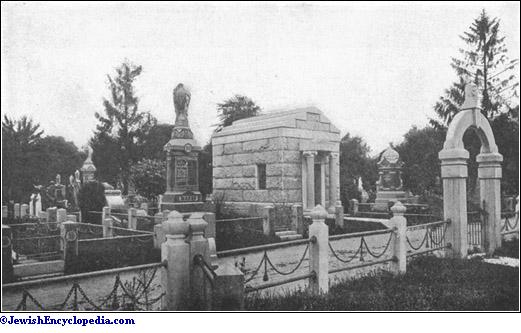
Zionism has its quota of adherents, there being twenty-four organizations in the city, which is the headquarters of the American Federation. The membership is about 5,000. The poor in Palestine are not forgotten, and are aided through the North American Relief Society (Hezekiah Kohn, president), as well as through private sources.
Of trade-unions the Allied Hebrew Trades is the only distinctively Jewish organization, although in those trades in which many Jews are employed the labor-unions have a considerable Jewish membership. The executive officer of the United Garment Workers was until the summer of 1904 Henry White; he is likewise a member of the Civic Federation—an organization of employers, working men, and publicists which was established in order to promoteindustrial peace. Associated with him are Marcus M. Marks (president of the Clothing Association, an organization of employers) and Oscar S. Straus (president of the Board of Trade and Transportation), at whose initiative the Civic Federation was formed. The Chamber of Commerce has many Jewish members and one Jewish vice-president (Jacob H. Schiff).
Politically the Jews are fairly divided between the two leading parties, although many ally themselves with the Socialists. A leading Socialist journal is "Vorwärts," published in Yiddish and edited by Abraham Cahan. Other Yiddish papers, all dailies, are the "News" (weekly ed., "Gazette"), "Journal," "World," "Jewish Abend-Post," and "Herald," all but the last-named being owned or controlled by the Sarasohns. Other Jewish papers are the "American Hebrew," "Hebrew Standard," and "Arbeiter Stimme" (weekly), "New Era," "Jewish Home," "Menorah," "Zukunft," and "Maccabæan" (monthly): the "Maccabæan" is the Zionist, and the "Zukunft" the Socialist, organ.
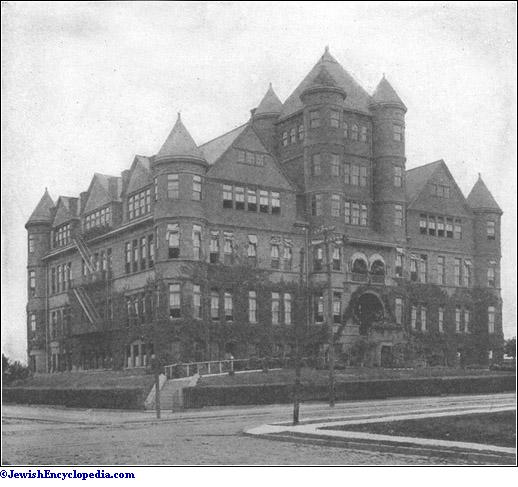
It is likely that Jews settled sporadically on Long Island from their first arrival at New York, but apparently not in numbers sufficient for the organization of a community; and it is a matter of tradition that they attended the congregations in New York, the more pious rowing over on Friday afternoons to spend the Sabbath-day with their brethren on Manhattan Island. About 1850 a number of Jews, in order to lessen the inconvenience in connection with attending worship in New York, abandoned their dwellings in the remoter parts of Brooklyn and moved nearer to the river front in the west and southwestern parts of Brooklyn. This caused movements to be set on foot for the establishment of two houses of worship on Long Island. The first was the Beth Elohim congregation in Williamsburg, established by fifteen Jews, who hired a small place for $150 a year. But the congregation grew rapidly, and a few years later a house of worship was erected in Keap street. In 1874 the younger generation adopted the Reform ritual, and the result was the secession of a numberof Orthodox members, who formed the Congregation Ahawath Achim.
Beth Israel.The second movement for the founding of a congregation began in the neighborhood of the present Brooklyn city hall, about 1854. Only twelve members were concerned, and on each Sabbath they worshiped in the house of one of their number. They named their congregation Beth Israel, and for the Passover and the autumnal festivals they brought a ḥazzan from New York. Their house of worship is now on Boerum place and State street, near the great business district of Brooklyn. Until the year 1879 the congregation was strictly Orthodox, but in that year certain reforms were adopted.
The Reform movement had its inception in 1869, when a number of Jews left the Orthodox synagogues. This resulted in the founding of Temple Israel. A charter was procured from the legislature, a hall was temporarily rented, and during the same year a church building in Greene avenue, near Adelphi street, was purchased and converted into a synagogue. In Nov., 1887, lots were purchased at Bedford and Lafayette avenues, and in April, 1891, was laid the corner-stone for the temple, which was dedicated in April, 1892. The number of synagogues in that vicinity shows where the increase of the Jewish population of Brooklyn first appeared.
Effect of Russo-Jewish Immigration.The so-called "third period" of Jewish history in Brooklyn commenced in 1882, when the influx of Russian Jewish immigrants began. Russian Jews settled among their coreligionists in the Williamsburg district. The older Jewish residents of Williamsburg began to remove to other districts, and many Jewish synagogues of early establishment were left in possession of the new arrivals. Williamsburg, however, was not destined to form the living center of the fresh contingents of immigrants from Russia, Rumania, and Galicia.
At the end of 1886 some New York immigrant Jews of speculative propensities purchased a number of lots in the district known as Brownsville, which lots were offered for sale to immigrant Jewish residents of New York. In the course of three years about two hundred houses and three synagogues were erected in Brownsville. The streets were not paved and were badly lighted. In 1895 it attracted the attention of some wealthy Jewish inhabitants of Brooklyn, and they hastened to help their coreligionists. A building was soon erected at Pitkin avenue and Watkin street, and became the home of the Hebrew Educational Society, which is managed on the same lines as the Educational Alliance in East Broadway, New York. The founders of the institution appealed to the authorities in behalf of the Jewish inhabitants of Brownsville, and in the course of two years considerable improvements were made.
When entire streets of the east side of New York were altered and innumerable houses were demolished to make room for parks and for the approach to the Williamsburg bridge, thousands of Jews moved to Brownsville, and it is estimated that there are now (1904) not less than 20,000 Jewish inhabitants in that district, with fourteen synagogues. The majority of the Brownsville Jews travel daily to New York, where they either have places of business or are employed in various factories.
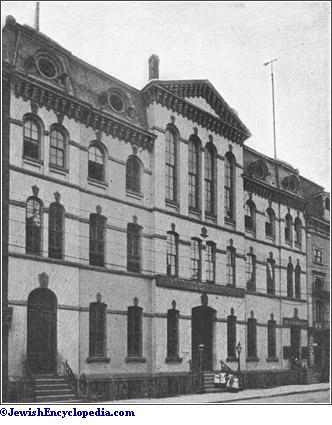
The most important Jewish benevolent institution in Brooklyn is the Hebrew Orphan Asylum Society, which was incorporated in Aug., 1878. On Jan. 1, 1879, a house at McDonough street and Stuyvesant avenue was opened for the reception of orphans. Six years later ground in McDonough street, adjoining the original building, was bought, and the corner-stone of the building was laid June 26, 1883.In May, 1892, the corner-stone of a new asylum building on Pacific and Dean streets was laid. This building cost $235,000, and was dedicated Dec., 1892. It accommodates about 400 children.
Cemeteries.For almost two centuries the Jewish dead of Brooklyn were taken to Manhattan Island for burial. But when, for sanitary reasons, the old burial-places were closed, the Manhattan Jews established cemeteries in Brooklyn. The oldest known is the Washington Cemetery, situated about two miles beyond the city limits and just outside the village of Parkville, Long Island. It appears that at its establishment about 1860 there were no sectarian restrictions placed upon interments. However, few persons of other communions have been buried there since the Jews took possession of it. Within the last twenty years about fifty acres have been added to it. Hebrew lodges and congregations, societies and individuals, have purchased nearly three-fourths of its acreage. Among the other Jewish places of burial are: Ahavath Chesed, thirteen acres in East Williamsburg; Shearith Israel and Temple Beth-El, both in Newtown, and six and ten acres respectively; Salem Fields, at Jamaica avenue and Market street; Mount Nebo, fifteen acres on the Fresh Pond Road in Queens county; Machpelah, forty acres in Newtown; and Maimonides, seven and one-half acres near Ridgewood.
In 1904 Brooklyn contained over thirty congregations, a Talmud Torah, a hospital and dispensary, various benevolent associations, clubs, lodges, and Zionist societies. Its oldest rabbi then was Leopold Wintner, for many years connected with the Beth Elohim congregation. Its Jewish population in that year appears to have been not less than 100,000.
- History of the City of Brooklyn (published by The Brooklyn Daily Eagle), pp. 362, 544, 631, 655;
- W. W. Munsell, History of Kings County, p. 1088, New York.































